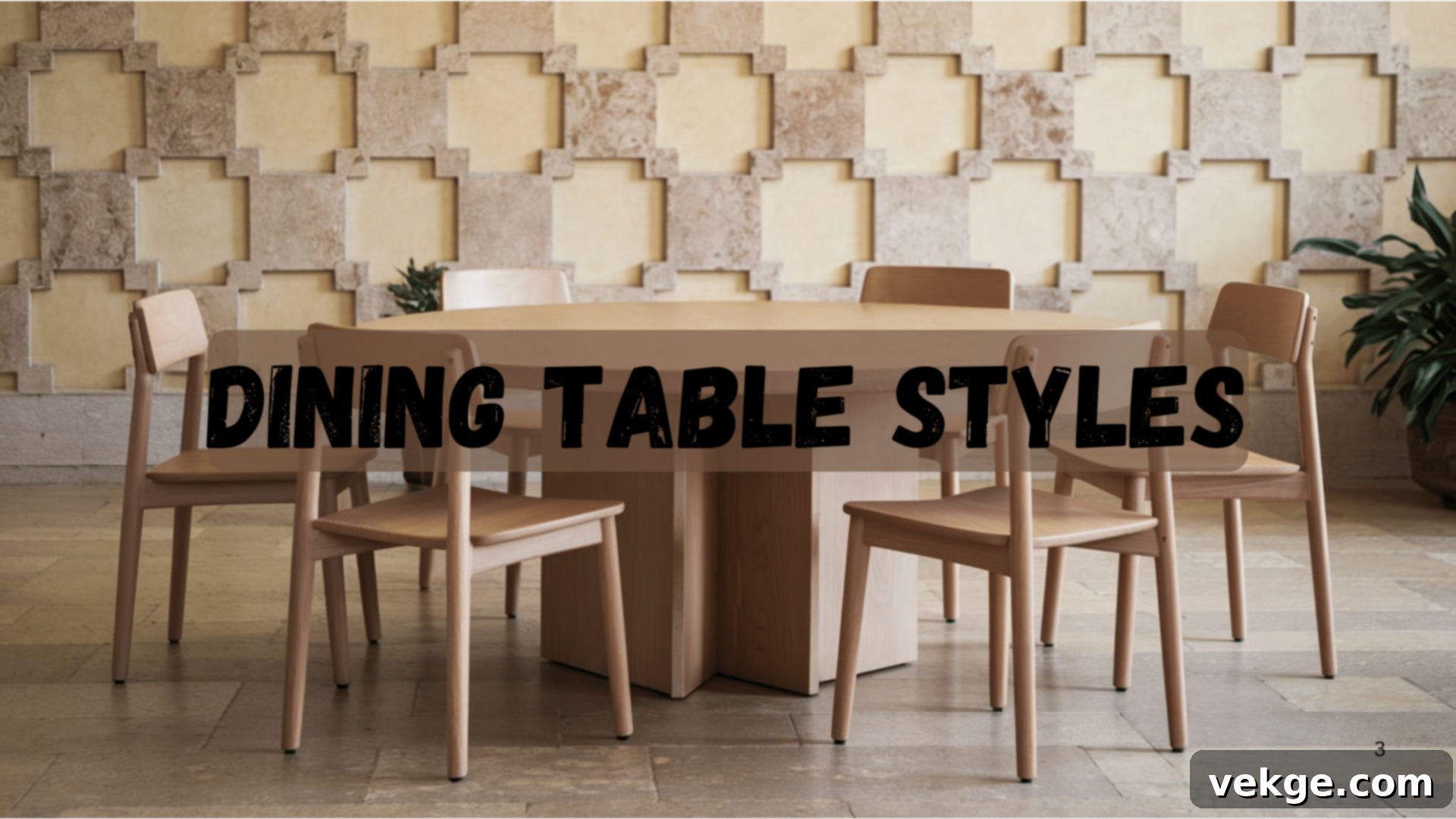The Ultimate Guide to Choosing & Styling Your Dining Table: Expert Tips for Every Home
Your dining table is more than just a place to eat; it’s often the heart of your home, a gathering spot for family, friends, and cherished memories. If you’re looking to elevate your dining space and make your table a stunning focal point, you’ve come to the right place. This comprehensive guide will walk you through everything you need to know, from selecting the perfect table to styling it for any occasion.
In this article, we’ll provide simple yet effective tips for styling your dining table, ensuring it looks polished and inviting, whether it’s for daily meals or a grand celebration. We’ll show you how to create a space that is both functional and beautifully designed.
Here’s what you’ll uncover in this essential guide:
- How to choose the ideal dining table size and shape for your specific needs.
- Exploring various dining table bases and materials to match your aesthetic.
- In-depth insights into different dining table styles, from traditional to modern.
- Practical tips for setting up place settings and selecting the right table décor.
- Strategies for seamlessly matching your dining table with your room’s overall style.
- Creative ideas for fostering a warm and welcoming atmosphere.
- Budget-friendly options and essential care and maintenance advice.
Our goal is to help you overcome the challenge of transforming your dining table into an inviting and stylish centerpiece. You can trust that these expert tips are practical, easy to implement, and designed to help you create a space you’ll absolutely adore. Let’s dive into the art of dining table selection and styling!
How to Choose the Right Dining Table Size?
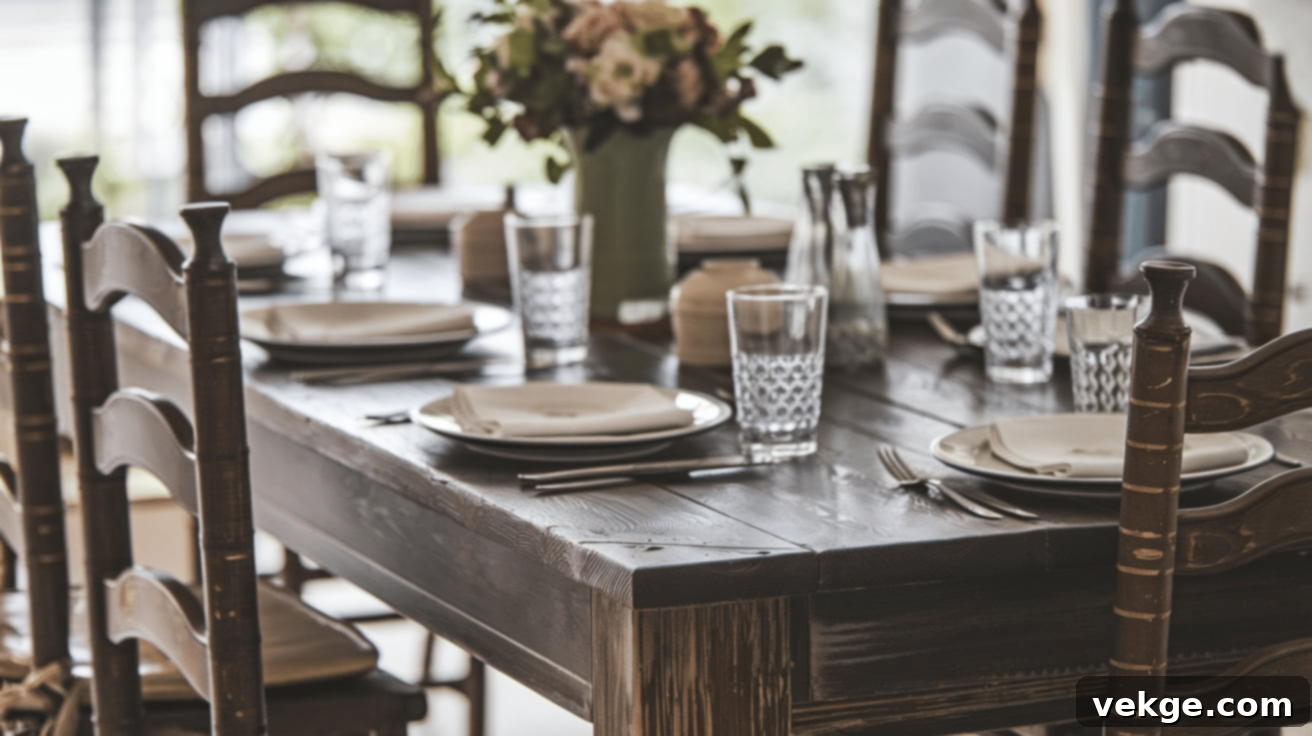
Selecting the correct dining table size is fundamental to making your dining area feel comfortable, functional, and aesthetically pleasing. It can seem daunting, but with a few simple guidelines, you’ll find the perfect fit for your home.
Firstly, accurate measurement of your dining space is crucial. Before you even start looking at tables, grab a measuring tape. You need to ensure ample room for people to move around the table comfortably, pull out chairs, and walk past without feeling cramped. A good rule of thumb is to allow at least 3 feet (approximately 90-100 cm) of clearance between the edge of your dining table and any surrounding walls or other furniture. This space ensures ease of movement and prevents your dining area from feeling overcrowded.
Next, consider how many people you typically need to seat on a regular basis. This will largely dictate the length or diameter of your table. Here’s a quick guide to help you determine the appropriate size:
- For 4 people: A table that’s approximately 36-48 inches (90-120 cm) long or wide is usually sufficient. This could be a small square, round, or rectangular table.
- For 6 people: A table around 60-72 inches (150-180 cm) long is ideal. Rectangular or oval shapes are common for this capacity.
- For 8 people: Look for a table that’s 72 inches (180 cm) long or more. For larger gatherings, tables stretching up to 96 inches (240 cm) or extendable options are excellent choices.
- For 10 or more people: You’ll need a table upwards of 100 inches (250 cm), or a large extendable table that can adapt to varying guest numbers.
Don’t forget to consider the table shape as well, as it significantly impacts how it fits into your room and its seating capacity. Rectangular tables are highly versatile and work well in most elongated dining rooms, offering a traditional and efficient use of space. Round tables, on the other hand, are fantastic for smaller or square rooms, promoting intimate conversation and often feeling less imposing due to their lack of sharp corners. Oval tables offer the best of both worlds, providing the capacity of a rectangular table with the softer lines of a round one.
By keeping these practical tips in mind, you’ll be well-equipped to find the perfect dining table size and shape that complements your room’s dimensions and your lifestyle, ensuring both comfort and style.
Exploring Different Types of Dining Table Bases
Beyond the tabletop, the dining table base plays a crucial role in defining the table’s overall style, stability, and even the comfort level for those seated around it. It’s a key design element that can either enhance or detract from your dining experience. Let’s delve deeper into the various types of dining table bases and what makes each one unique.
1. Four-Legged Base

The four-legged base is arguably the most classic and ubiquitous design. This configuration features a leg at each corner, providing exceptional stability and a sense of balance. Its timeless appeal makes it suitable for almost any table shape, from the traditional rectangular to contemporary round designs. These bases are incredibly versatile, fitting seamlessly into various decor styles from farmhouse to modern industrial.
- Pros: Offers superior stability and a timeless, versatile aesthetic. Widely available in many materials and styles.
- Cons: Depending on the thickness and placement of the legs, it can sometimes limit legroom for those seated directly at the corners, especially with bulkier designs.
2. Pedestal Base
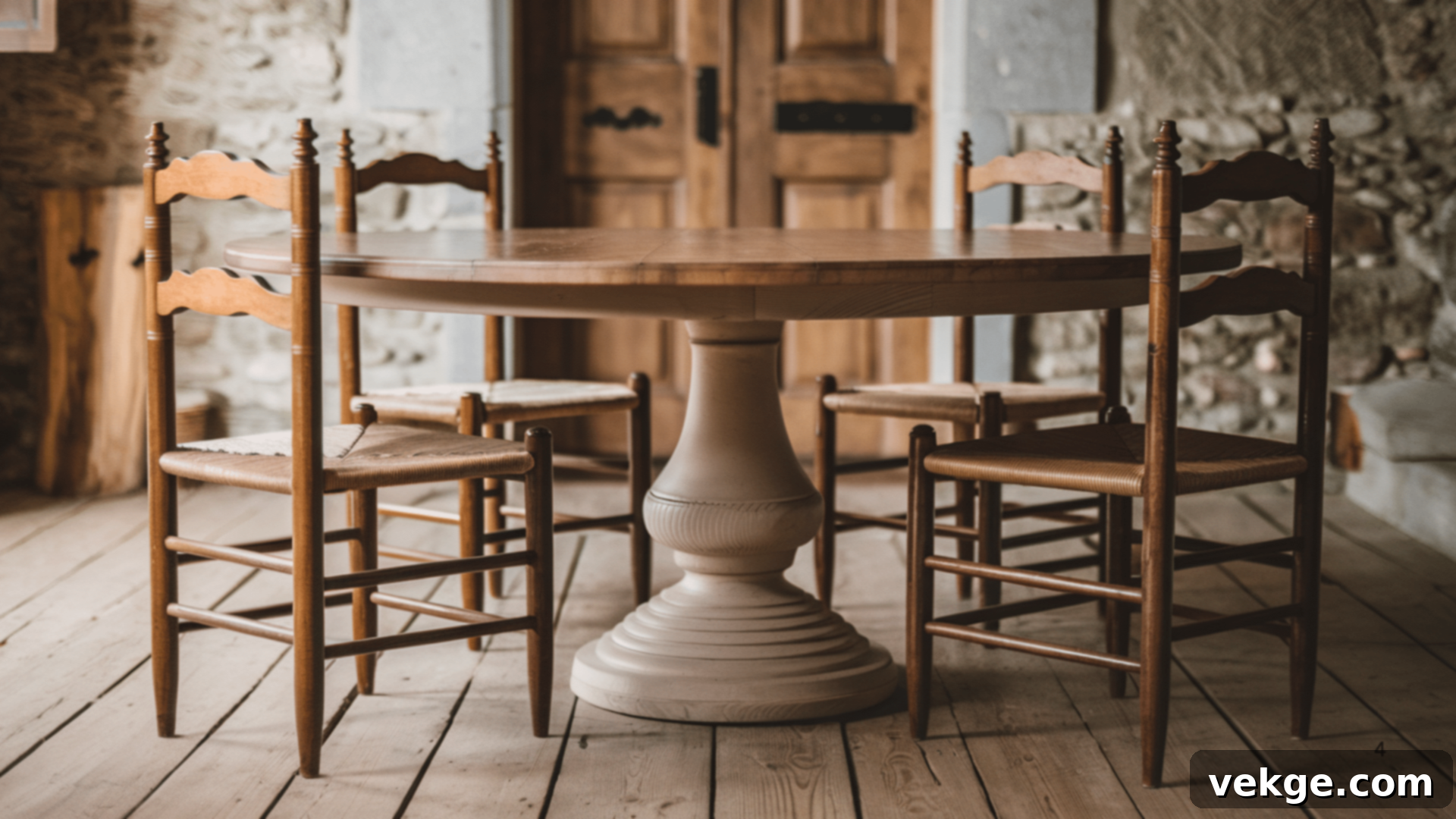
A pedestal base distinguishes itself with one central column or a substantial central support system that holds the tabletop. This elegant style is a fantastic choice for smaller rooms or for anyone prioritizing maximum legroom. Without legs at the corners, guests can sit anywhere around the table without obstruction, making it highly flexible for seating arrangements.
- Pros: Excellent for tight spaces and offers significantly more unobstructed legroom. Promotes a more intimate dining experience as no one is “stuck” with a leg.
- Cons: While many are sturdy, some designs, particularly with very large or heavy tabletops, might not feel as inherently stable as a four-legged base. Stability depends heavily on the base’s diameter and weight.
3. Trestle Base

The trestle base is characterized by two supportive uprights, often resembling “A” frames or solid blocks, connected by a horizontal beam (the trestle) running underneath the tabletop. This robust and visually striking base is a popular choice for achieving a rustic, farmhouse, or industrial aesthetic. Its sturdy construction suggests durability and a handcrafted feel.
- Pros: Provides a unique, sturdy design with strong visual impact. Excellent for creating a cozy, communal feel.
- Cons: The central beam can sometimes interfere with legroom for those sitting directly over it. It may not align with very modern, sleek, or minimalist decor styles.
4. Cross Base

A cross base typically features two distinct legs or structural elements that intersect in an “X” shape, often centrally located or supporting the tabletop from two points. This design adds a modern, stylish, and often architectural touch, making it a favorite for contemporary, industrial, or even minimalist dining tables. It offers a sophisticated visual interest that deviates from traditional leg setups.
- Pros: Highly stylish, eye-catching, and can act as a sculptural element in the room. Offers good stability with proper engineering.
- Cons: The design can sometimes reduce practical legroom, similar to a trestle, depending on the height and spread of the ‘X’. It might not be the most practical choice for very large families needing every inch of under-table space.
5. Hairpin Legs
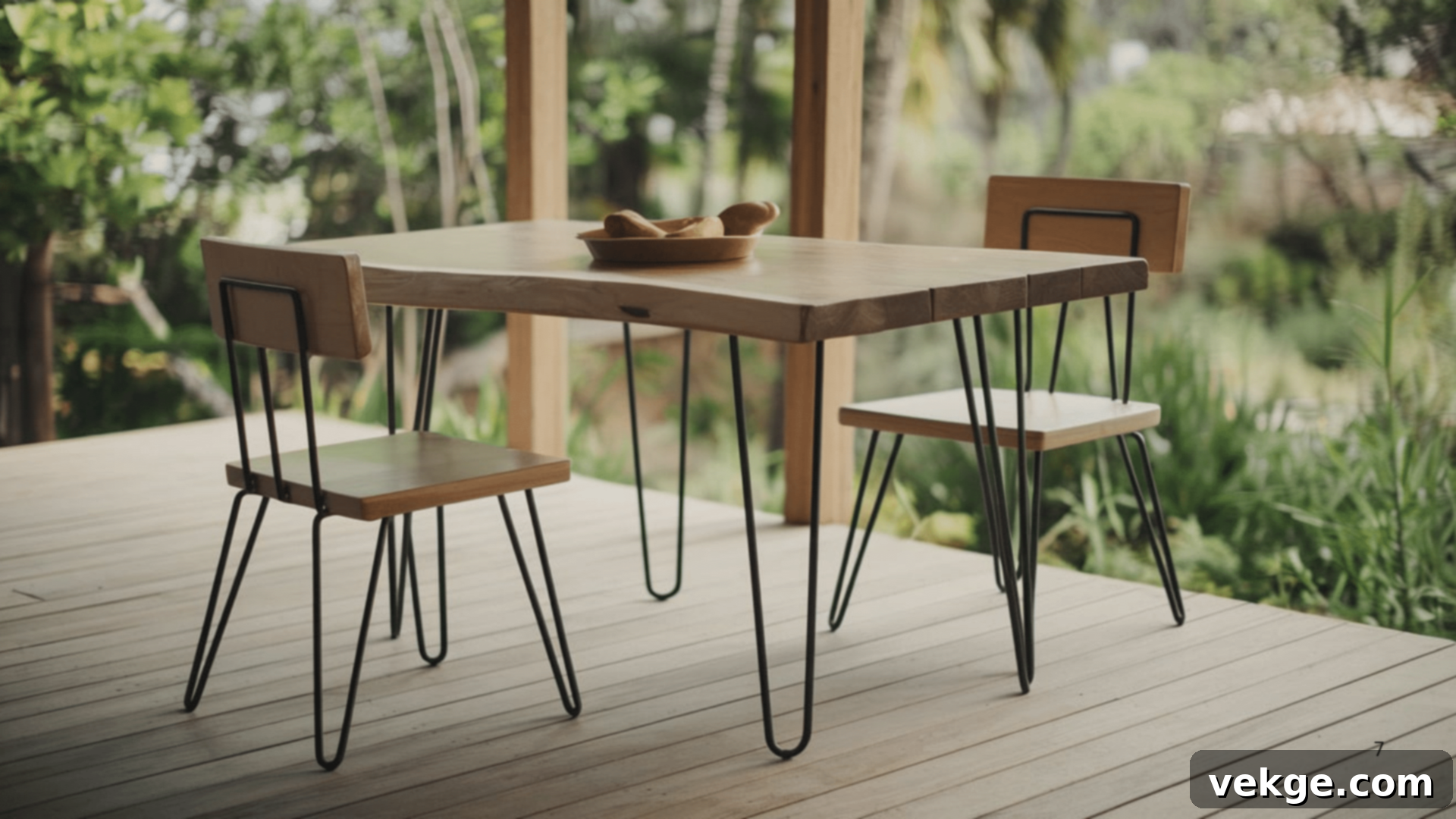
Hairpin legs are thin, often metal, legs that typically consist of two or three rods bent at angles, creating a distinctive “hairpin” shape. They are a hallmark of mid-century modern design, offering a sleek, minimalist, and airy look. These legs are frequently paired with smaller tables or desks, contributing to a sense of lightness and openness in a room.
- Pros: Provides a minimalist, mid-century modern style that suits contemporary and smaller spaces. They offer good legroom due to their slender profile.
- Cons: Generally less sturdy than thicker, more robust leg designs, making them less suitable for very large or heavy table tops. Can sometimes wobble if not properly fastened or if the table is oversized.
6. Arc or Bow Base
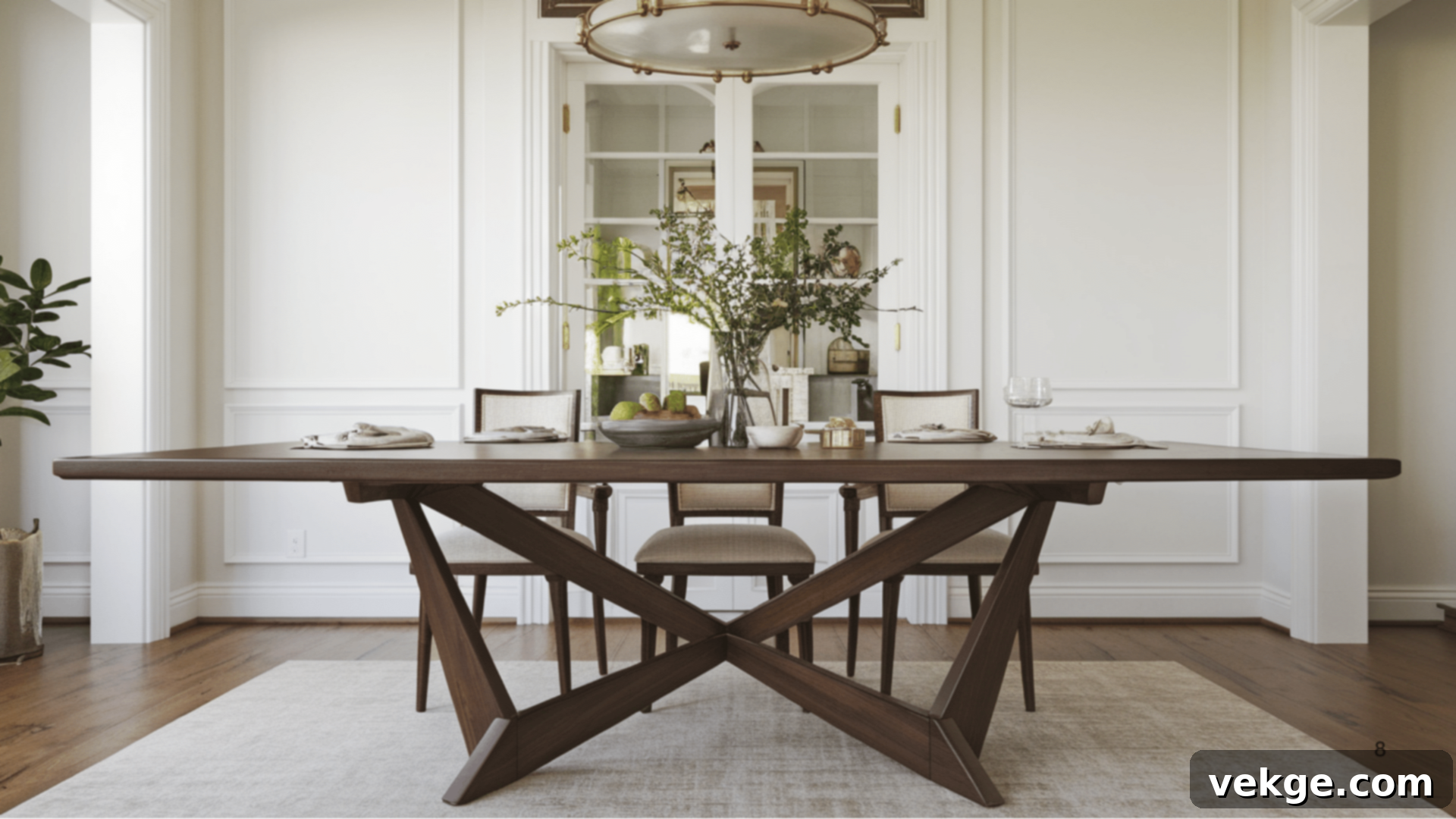
An arc or bow base features gracefully curved legs or a single, sweeping support structure that often creates an elegant and artistic silhouette. This design is less about sheer practicality and more about visual impact, commonly found in more luxurious, contemporary, or art-inspired table designs. It adds a fluid, organic touch to the dining area.
- Pros: Visually striking, unique, and often acts as a sculptural focal point. Can create a sense of movement and sophistication.
- Cons: Depending on the design, it might be less practical for high-traffic, family-oriented spaces due to its potentially delicate appearance or unique leg placement that can limit seating flexibility.
Each dining table base possesses its own unique appeal and functional considerations. When making your choice, it’s essential to consider the overall style of your room, the amount of space available, and how you primarily intend to use your dining table. The right base will not only support your tabletop but also enhance the aesthetic and practical functionality of your entire dining area.
Understanding Dining Table Top Shapes
The shape of your dining table tabletop is a fundamental decision that greatly influences the flow, functionality, and overall ambiance of your dining room. It’s not just about aesthetics; it dictates how people interact, how much space is consumed, and how easily it integrates into your existing decor. Let’s explore the most common shapes and their suitability for different rooms and lifestyles.
7. Round Dining Tables
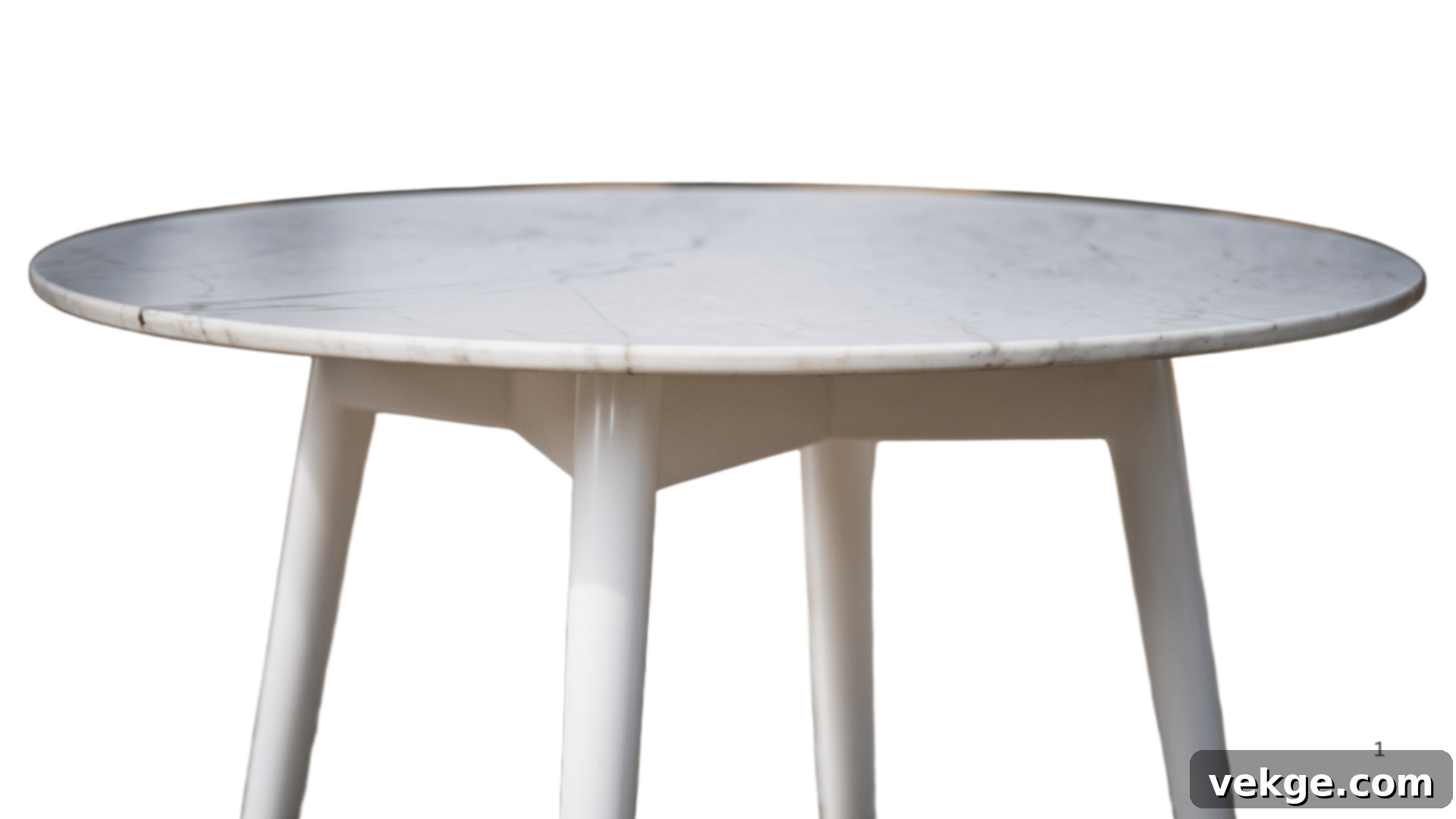
Round tables are celebrated for fostering intimacy and easy conversation, as everyone seated is equidistant from one another. Their soft, curved edges make them excellent for smaller dining areas or rooms with less angular furniture, helping to create a cozy and inviting atmosphere. They also work exceptionally well in square rooms, softening the rigid lines.
- Pros: Promotes easy conversation and a sense of equality, no sharp edges (safer for children), ideal for small or square spaces, and can often fit more people in a pinch compared to square tables of similar area.
- Cons: Limited seating capacity for very large groups (above 6-8 people), and larger round tables can be difficult to access the center of, requiring a lazy Susan or extra stretching.
8. Square Dining Tables
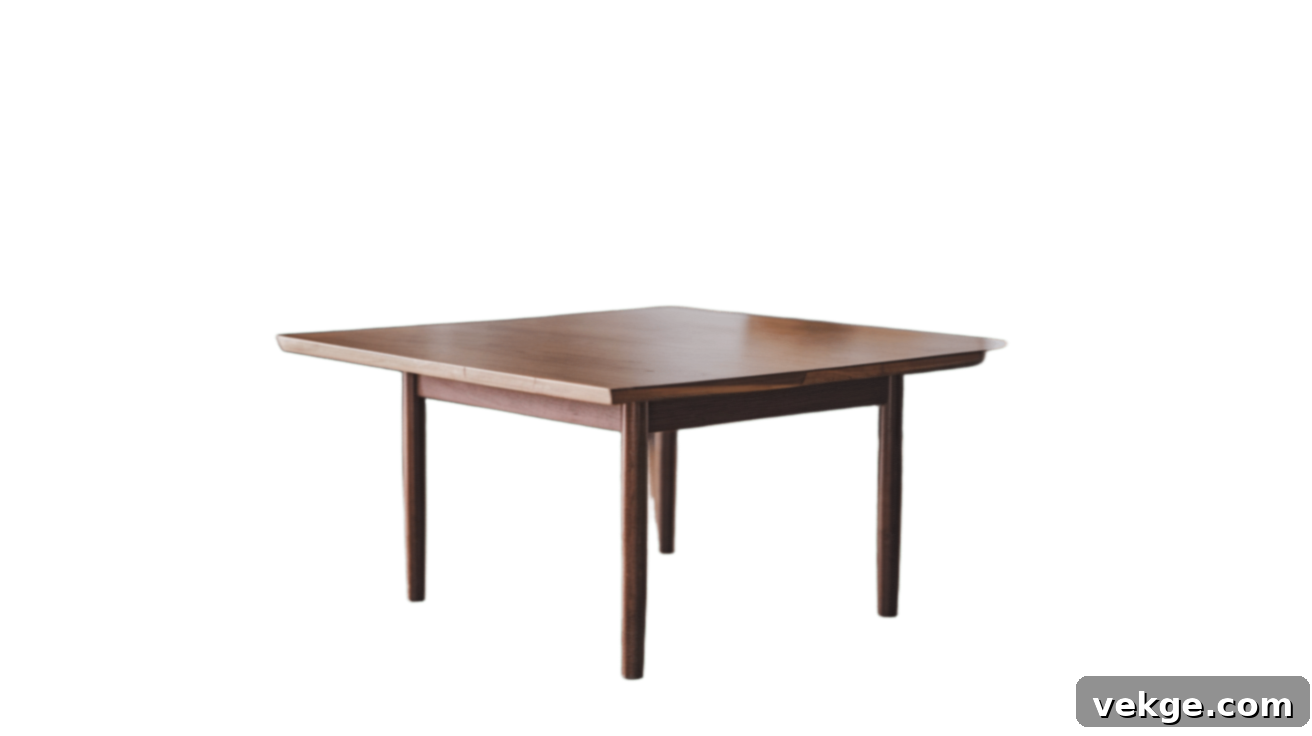
Square tables are a fantastic choice for square rooms, creating a visually harmonious and balanced look. They are perfect for small families or couples, offering a clean, symmetrical aesthetic that can feel very contemporary. When pulled away from a wall, they provide a very balanced and neat appearance.
- Pros: Symmetrical and aesthetically pleasing in square rooms, ideal for small families or more intimate dining. Offers a clean, modern look.
- Cons: Can feel cramped when trying to seat larger groups, as increasing the size makes conversation across the table more difficult. Not as efficient in narrow, rectangular rooms.
9. Rectangular Dining Tables
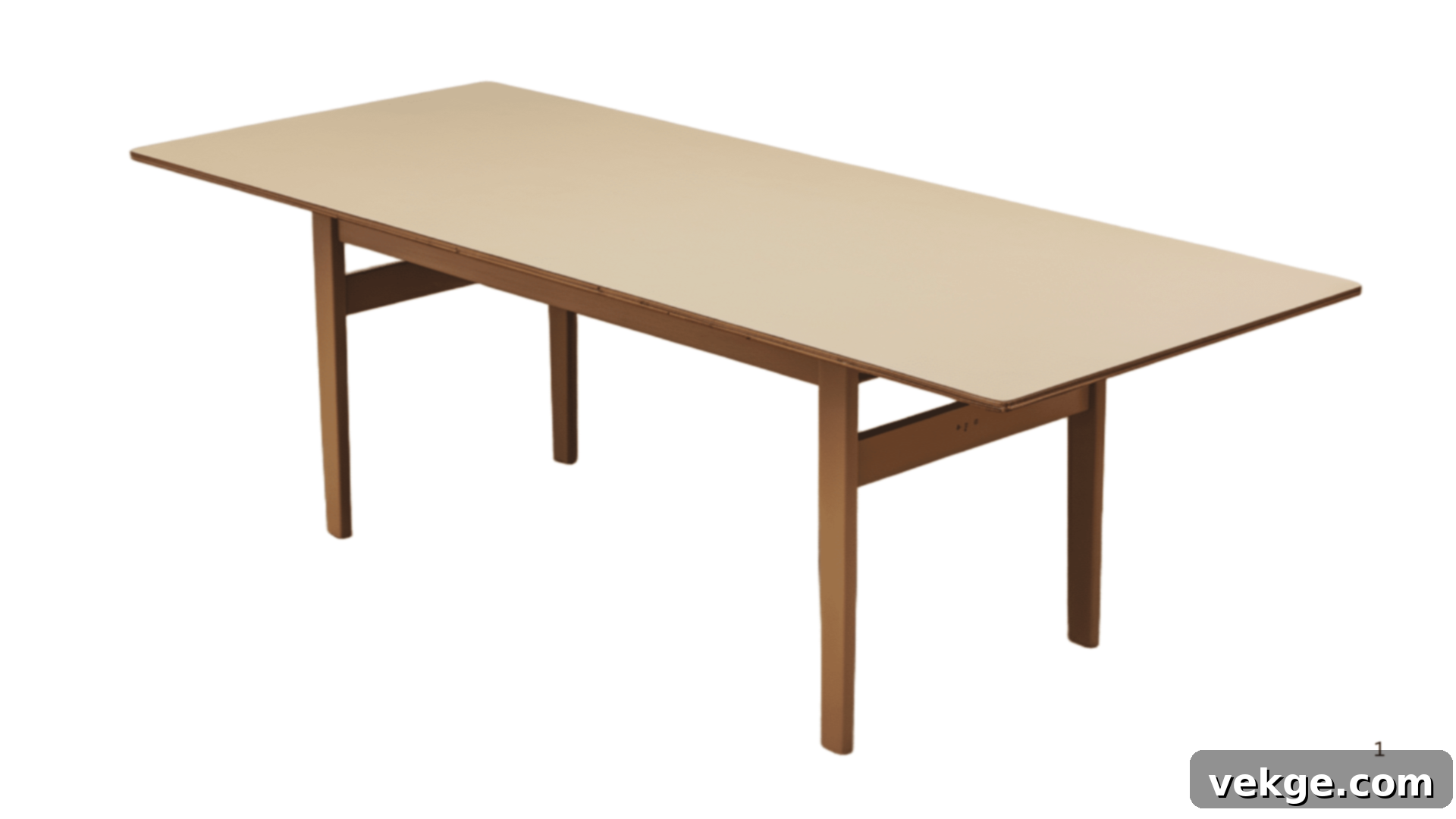
The most common and versatile shape, rectangular tables are a staple for larger rooms and families due to their excellent seating capacity. They efficiently utilize space in elongated dining rooms and are perfect for entertaining, offering ample surface area for food, drinks, and decor. Their classic appeal allows them to fit into almost any decor style.
- Pros: Accommodates many people comfortably, works exceptionally well in bigger and rectangular spaces, and is highly versatile for various table settings and centerpieces.
- Cons: Can sometimes appear too long or narrow in smaller rooms, potentially making the space feel more constricted. Sharp corners can be a concern for young children.
10. Oval Dining Tables
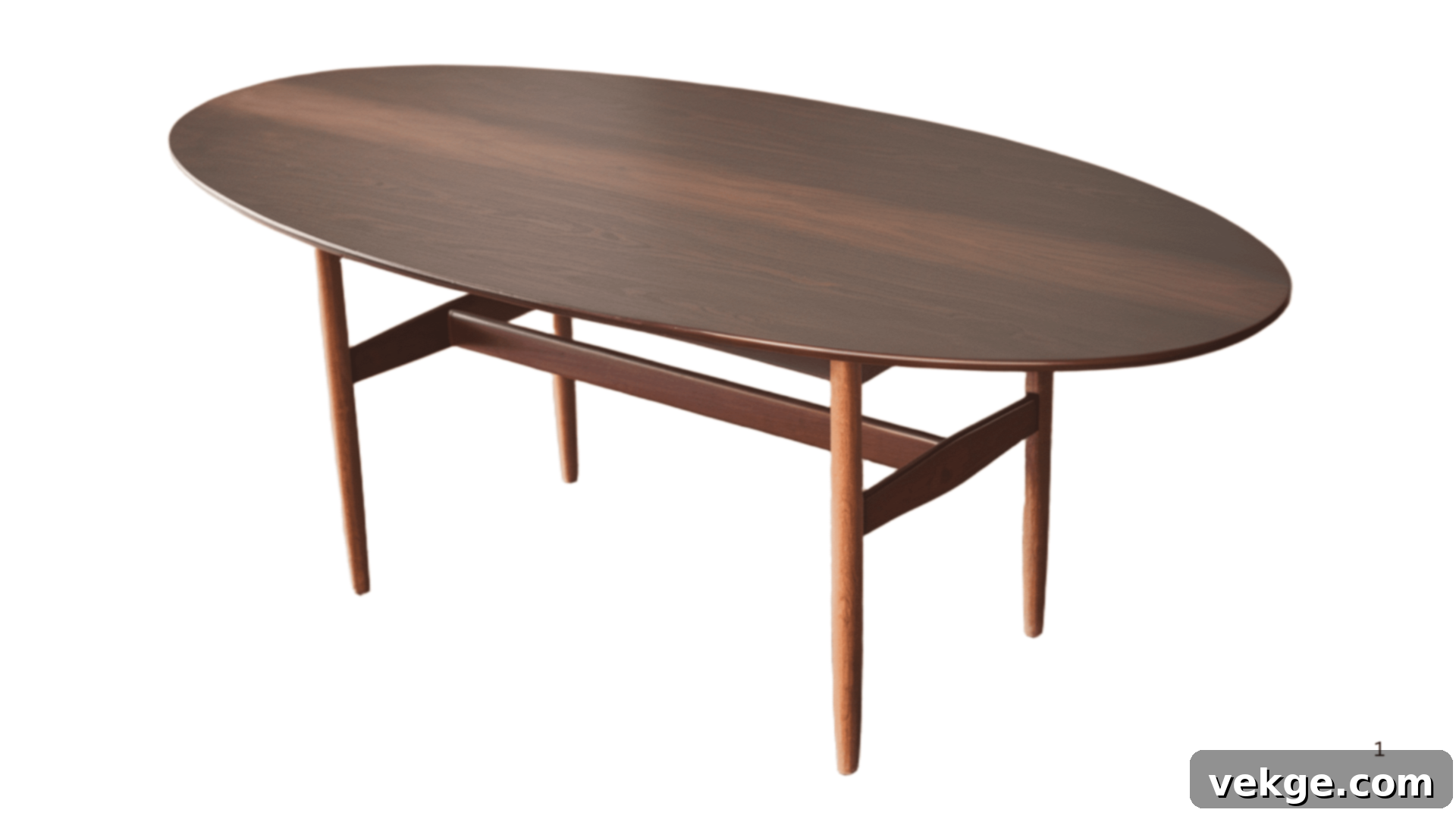
Oval tables offer a graceful alternative to rectangular tables, combining the benefits of both round and rectangular shapes. They provide a generous seating capacity similar to rectangular tables but with the softer, more fluid lines of a round table. The absence of sharp corners makes them safer for families with small children and also helps to improve traffic flow in tighter areas.
- Pros: Softer aesthetic than rectangular tables, offers more seating space (especially at the ends) without sharp corners, safer for children, and enhances flow in a room.
- Cons: Can still take up a significant amount of visual and physical space, similar to a rectangular table, depending on its overall dimensions.
11. Extendable Dining Tables
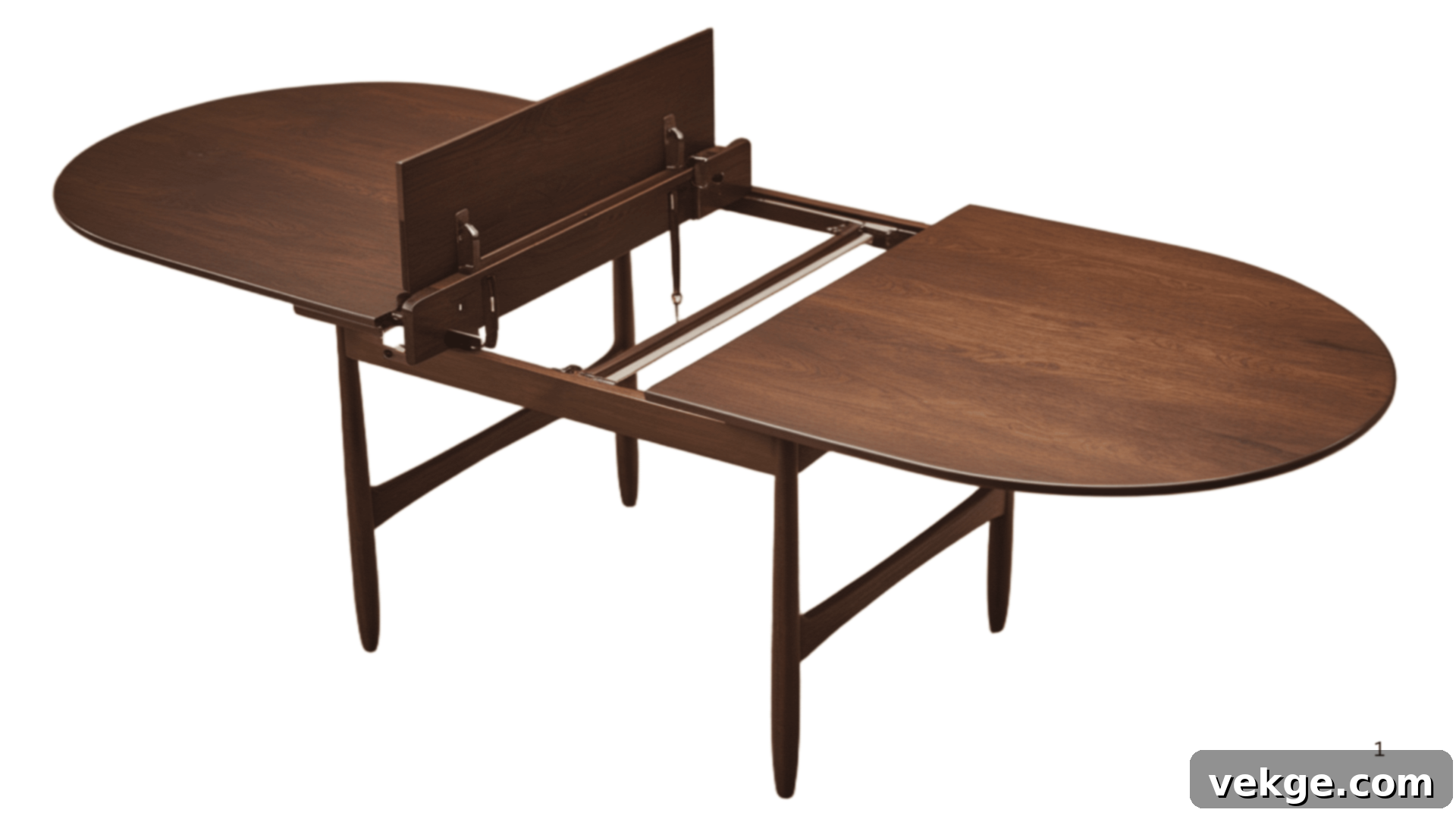
Extendable tables are the epitome of versatility and practicality, making them an excellent investment for dynamic households. They feature mechanisms that allow them to expand, often through leaves inserted in the middle or ends, or drop-leaf designs. This flexibility means you can adjust the table size based on the number of guests, making it ideal for both everyday use and hosting larger gatherings.
- Pros: Highly versatile for accommodating varying numbers of guests, excellent for hosting large gatherings while saving space daily.
- Cons: Depending on the design and extension mechanism, some extendable tables can feel a bit bulkier or less stable when fully extended compared to a solid, fixed table. The leaves need to be stored when not in use.
12. Butterfly Dining Tables
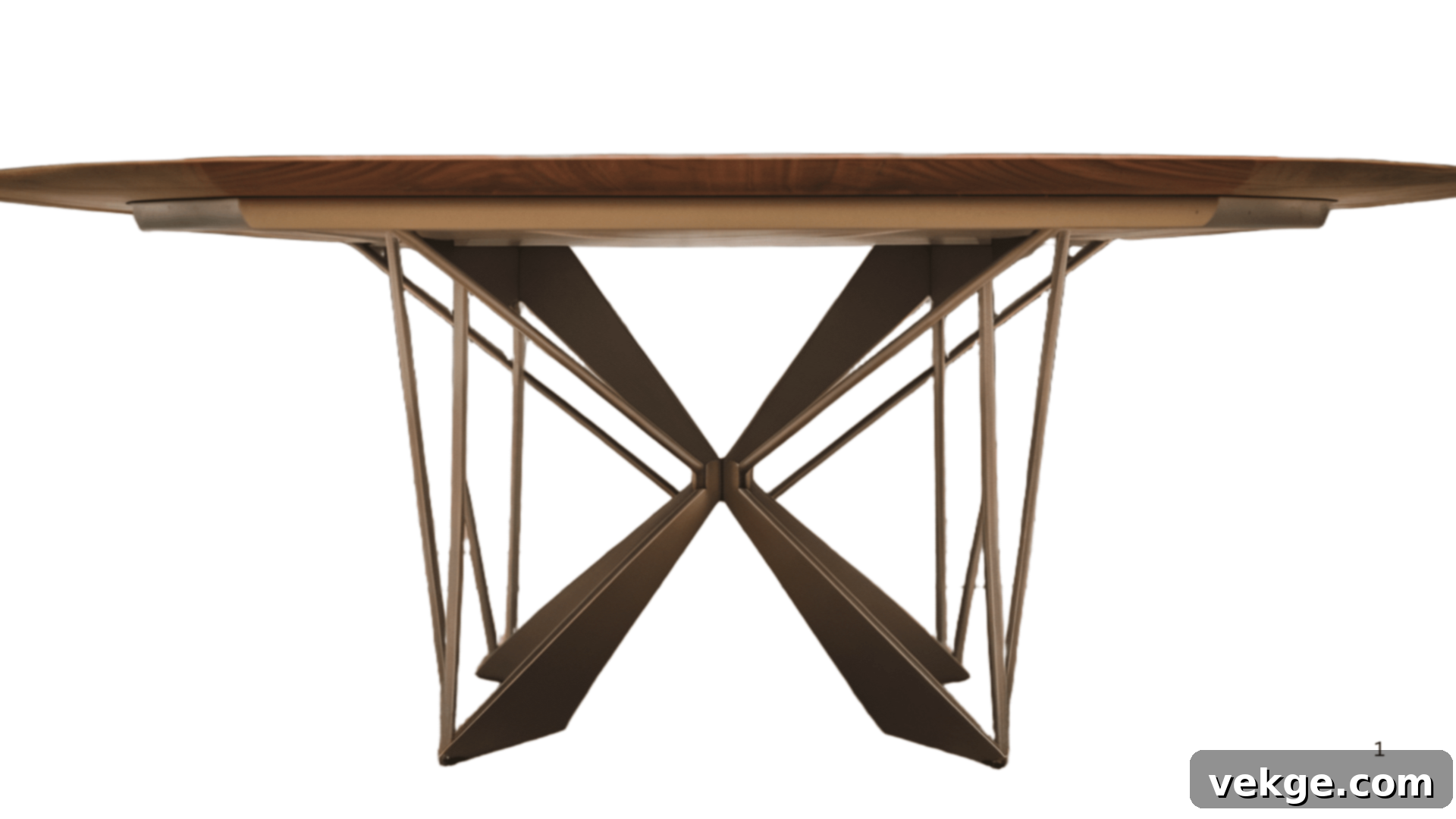
A specific type of extendable table, the butterfly dining table features integrated leaves that fold and store neatly underneath the tabletop when not in use. This ingenious design means you don’t need separate storage space for the leaves, making it incredibly convenient for small homes or apartments where every inch counts. They transform quickly from a compact size to a larger dining surface.
- Pros: Exceptionally space-saving and convenient for small homes, no need to store separate leaves, quick and easy to expand or retract.
- Cons: The folding mechanism can sometimes be less robust than solid table designs, and the tabletop might have visible seams where the leaves join.
13. Freeform or Irregular Dining Tables
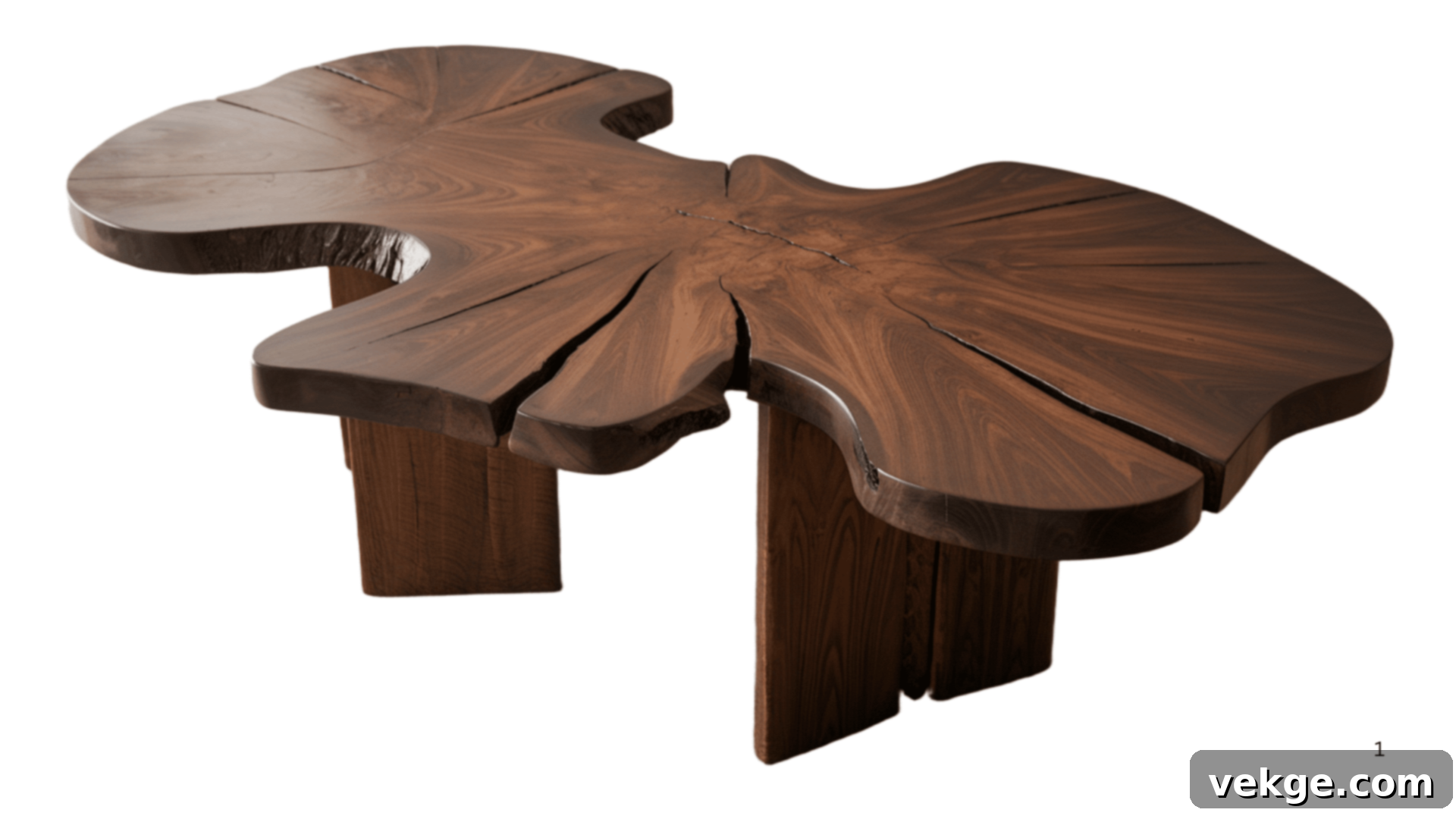
For those seeking a truly unique statement piece, freeform or irregular dining tables offer an artistic departure from conventional shapes. These tables often feature custom, asymmetrical, or organic designs, such as live-edge wood slabs or uniquely carved tops. They can become a bold focal point in modern, eclectic, or nature-inspired homes, reflecting a distinctive personal style.
- Pros: Unique design and artistic statement, incredibly eye-catching and distinctive, often highlights natural materials like wood.
- Cons: May not be practical for every dining situation due to uneven edges or less predictable seating arrangements. Can be more challenging to find compatible place settings or large serving dishes.
When selecting your dining table, always prioritize the size and shape of your room, alongside the number of people you regularly need to seat. The right shape can harmonize your space, improve traffic flow, and create a functional, stylish, and inviting environment for all your dining experiences.
Choosing the Best Material for Your Dining Table
The material of your dining table is a critical decision, influencing not only its aesthetic appeal but also its durability, maintenance requirements, and how it interacts with the rest of your home’s decor. Each material offers a distinct set of characteristics. Let’s explore the most popular options and their unique benefits.
Wood
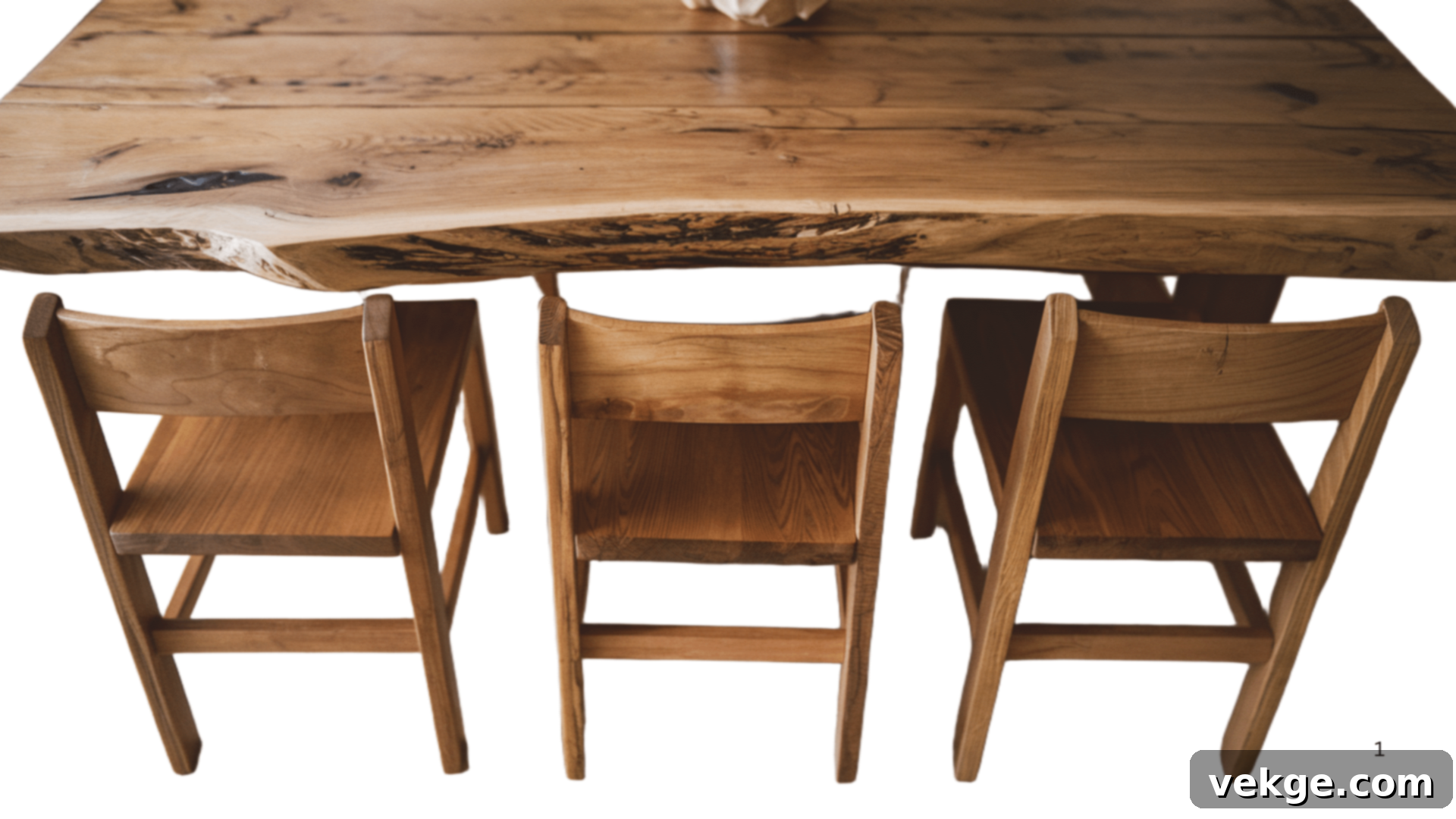
Wood is a perennial favorite for dining tables, cherished for its timeless appeal, natural warmth, and exceptional durability. From rich dark walnuts to light, airy oaks, wood offers immense versatility, fitting seamlessly into traditional, rustic, and even modern designs. The grain patterns add unique character, making each table a one-of-a-kind piece. Hardwoods like oak, maple, cherry, and walnut are excellent choices for their resilience.
- Pros: Incredibly long-lasting, highly versatile in terms of style and finish, can be refinished to extend its life, adds warmth and natural texture to any space.
- Cons: Can be prone to scratches, dents, and water rings if not properly protected. Requires periodic maintenance such as polishing or oiling to maintain its luster and prevent drying out.
Glass
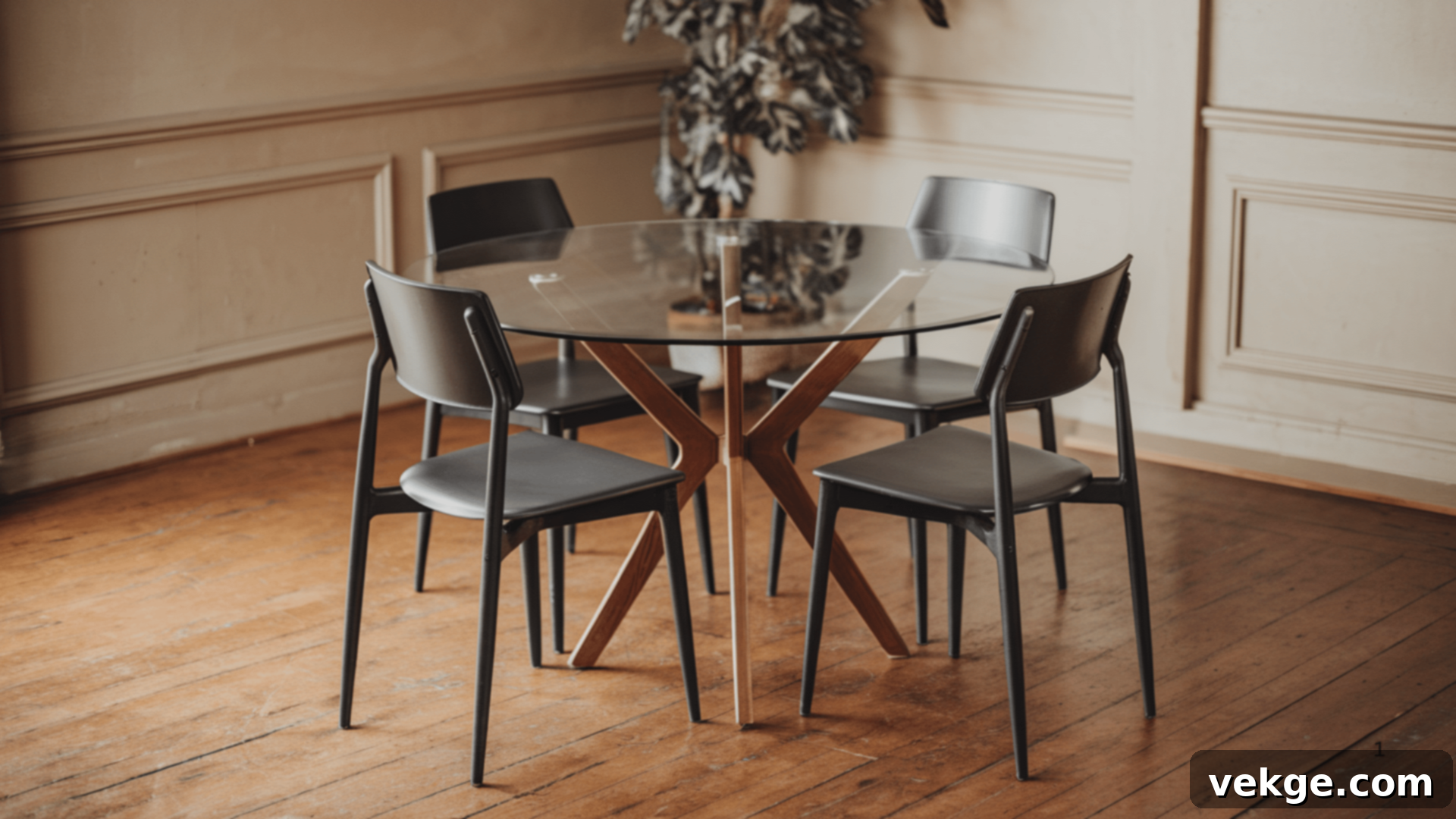
Glass dining tables epitomize a sleek, contemporary, and often minimalist aesthetic. Their transparency allows light to pass through, creating an illusion of space, which makes them particularly effective in smaller dining areas where they can help a room feel larger and more open. Tempered glass is commonly used for safety and durability.
- Pros: Easy to clean with a simple wipe, offers a modern and sophisticated look, visually lightens the space, and showcases interesting table bases underneath.
- Cons: Prone to visible fingerprints, smudges, and scratches, requiring frequent cleaning to maintain its pristine appearance. Can feel cold to the touch and there’s always a slight risk of chipping or breaking (though tempered glass is very robust).
Metal
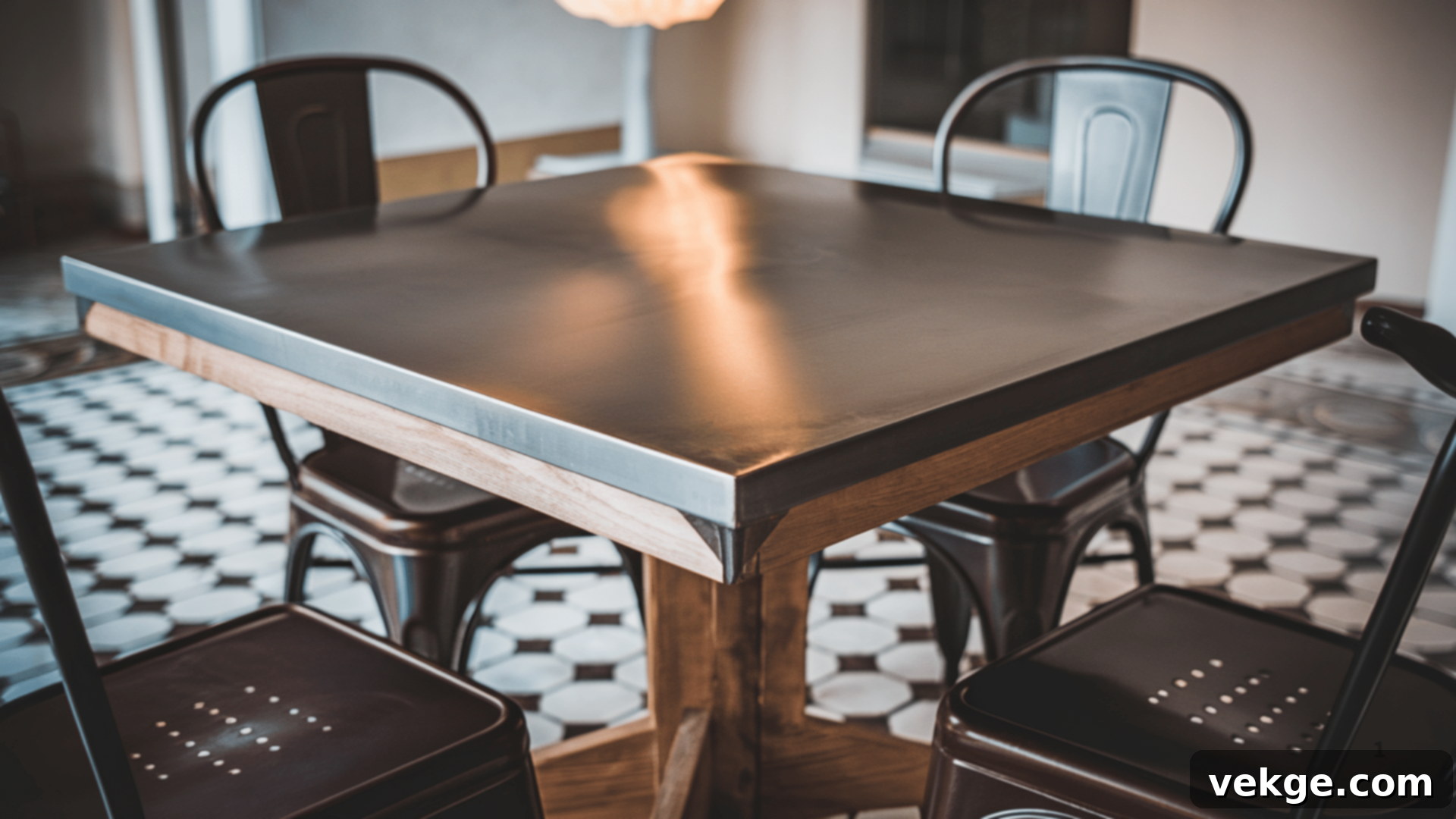
Metal dining tables, often featuring steel, iron, or aluminum, bring a distinct modern, industrial, or even rustic vibe to a dining space. They are renowned for their exceptional strength, stability, and ability to withstand heavy daily use. Metal tables are often paired with other materials like wood or glass for their tops, creating intriguing contrasts.
- Pros: Extremely strong, highly durable, low-maintenance, works exceptionally well in modern, industrial, or contemporary designs, and can be quite striking.
- Cons: Can feel cold and hard to the touch, might be heavy and difficult to move. Some metals can show scratches or develop a patina over time, which might not suit all tastes.
Marble
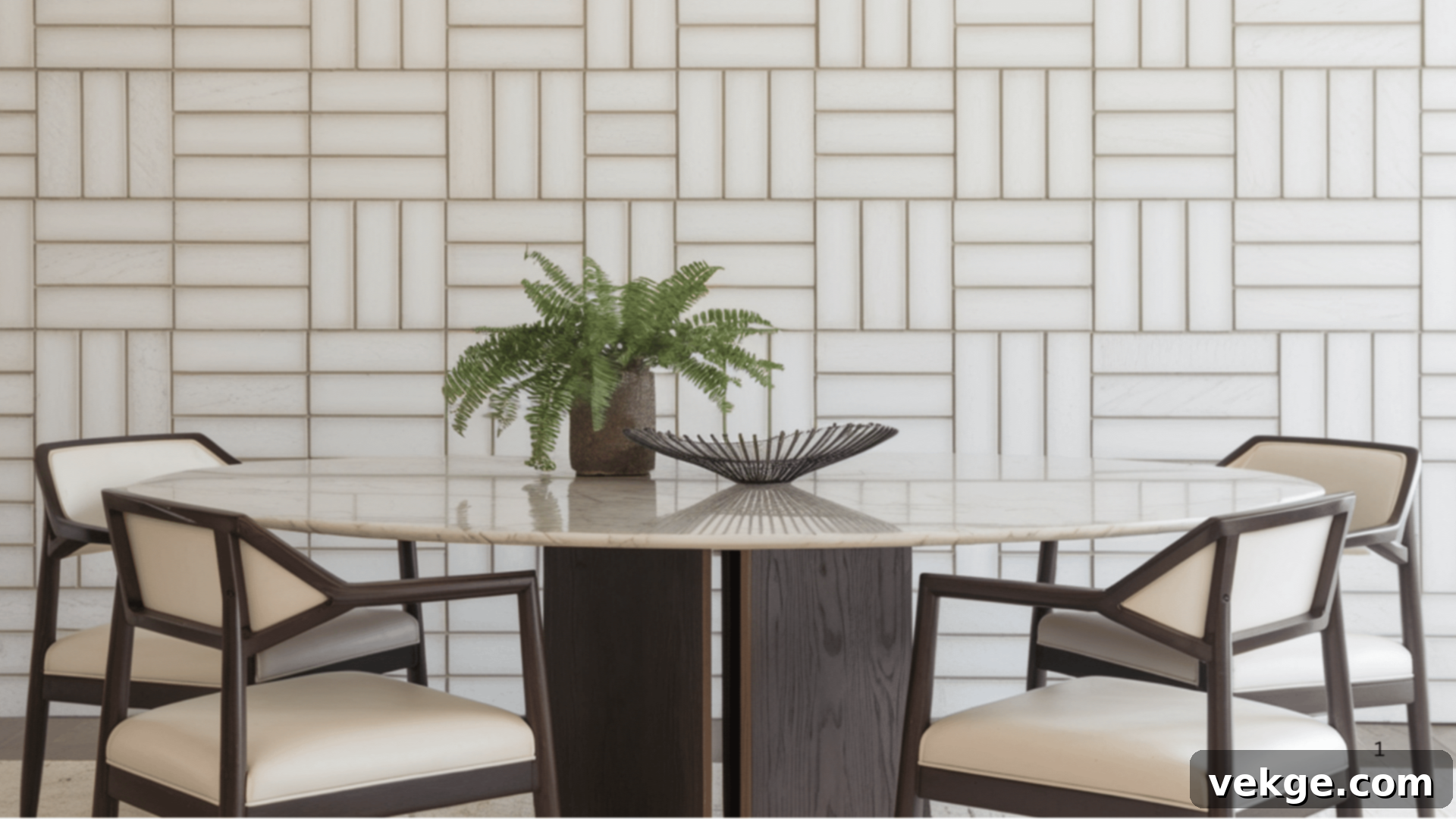
Marble dining tables exude luxury, elegance, and timeless sophistication. The natural veining patterns make each marble slab unique, turning your table into a functional work of art. It’s a high-end material that instantly elevates the aesthetic of any dining room, perfect for those seeking a grand and refined statement piece.
- Pros: Inherently stylish and luxurious, incredibly durable when properly cared for, and offers unique, beautiful veining patterns that add character. It can be a long-term investment piece.
- Cons: Requires meticulous care to avoid stains from acidic foods or liquids (it’s porous), can be extremely heavy and difficult to move. It is also generally one of the more expensive material options.
Plastic or Acrylic
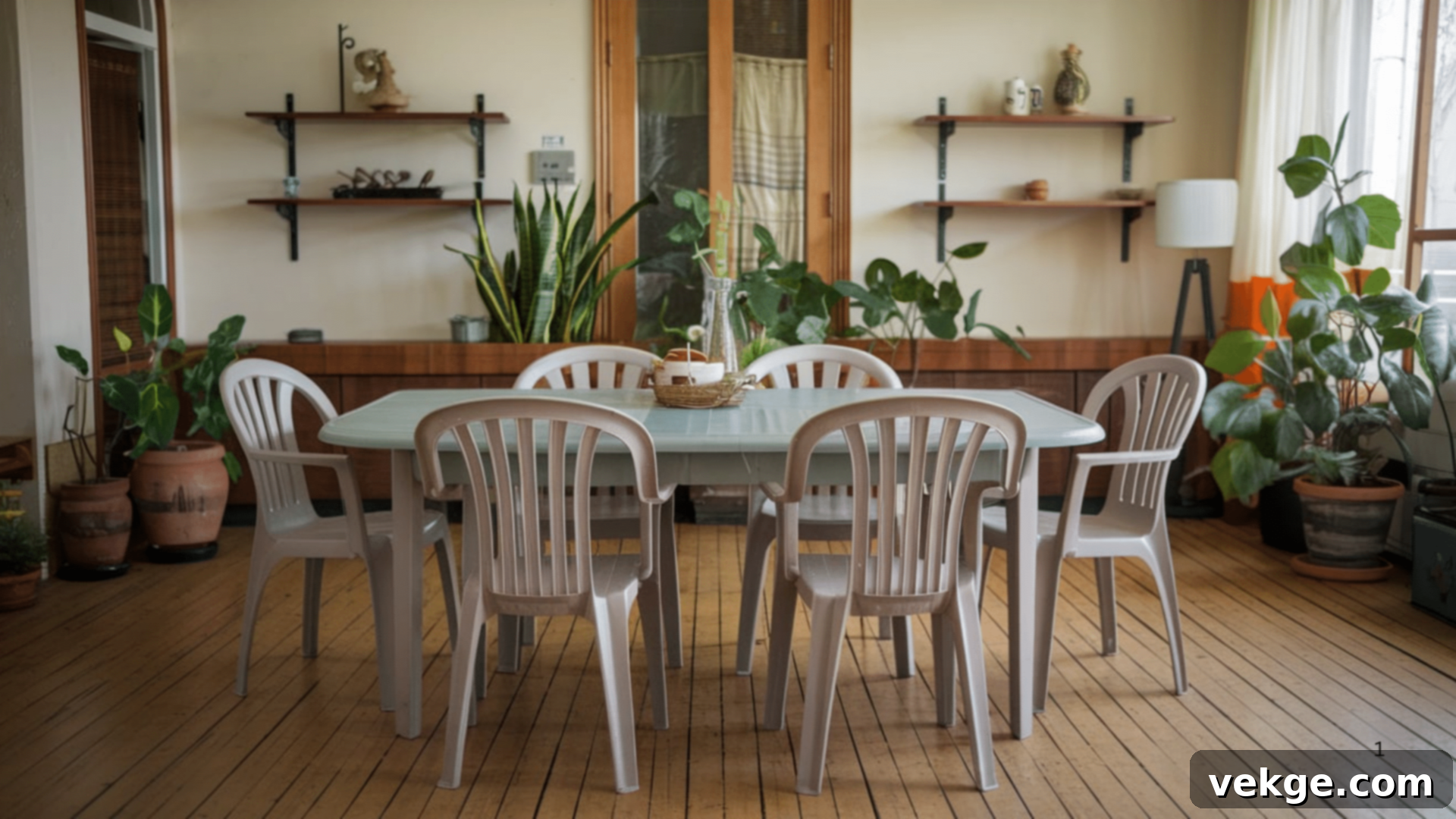
Plastic or acrylic tables are excellent for casual, contemporary, or outdoor settings, offering affordability and lightweight practicality. Modern designs have come a long way, with many stylish options available that are surprisingly durable and easy to maintain. Their versatility in color and shape also allows for playful and modern statements.
- Pros: Highly affordable, lightweight and easy to move, low-maintenance, and available in a wide array of colors and designs. Great for families with young children due to easy cleanup.
- Cons: Generally less durable and prone to scratches compared to harder materials like wood or stone. May not offer the same high-end feel or longevity as more premium options, and some plastics can yellow over time.
Concrete
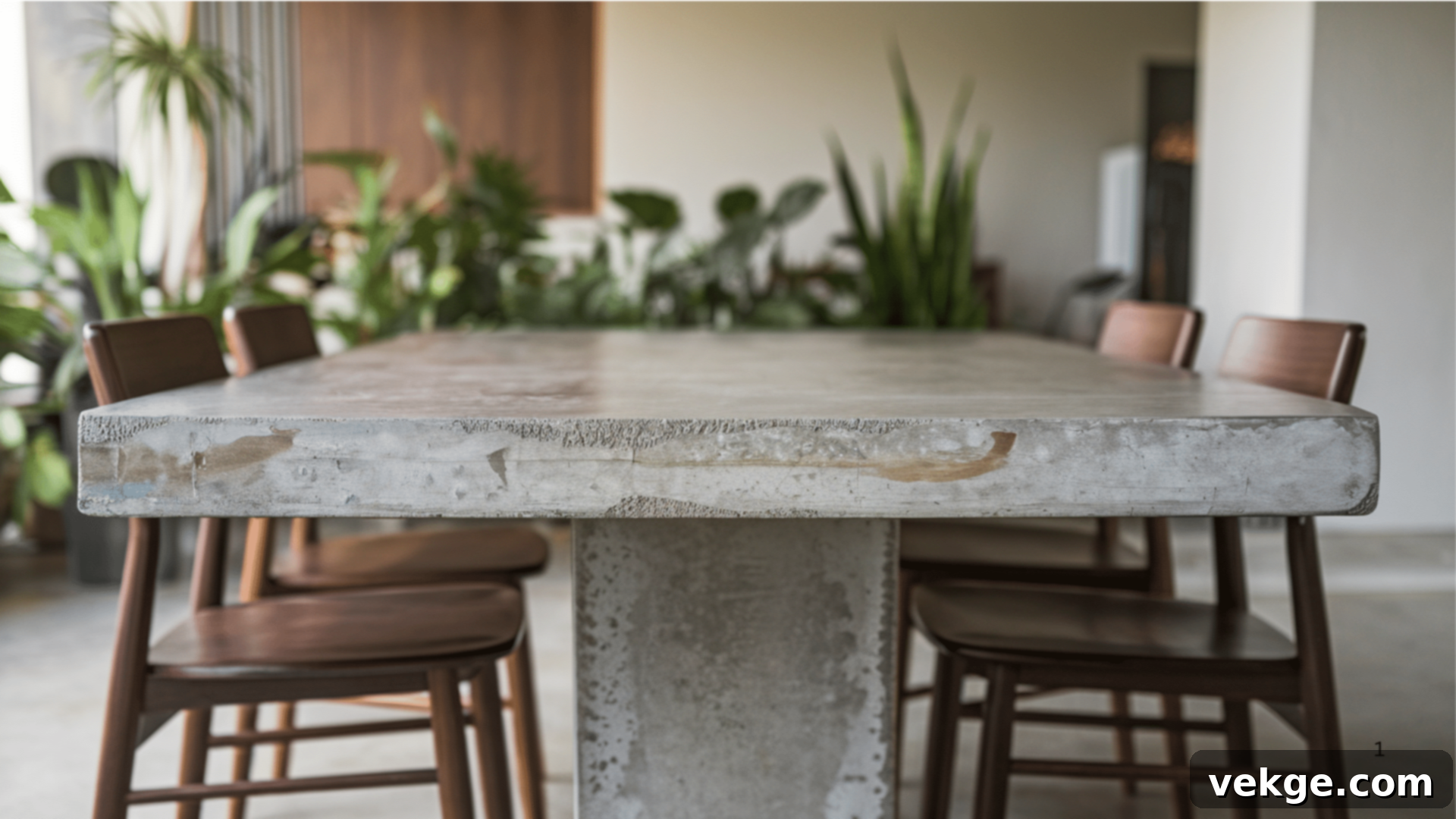
Concrete tables make a bold, industrial, and decidedly modern statement. They are incredibly durable, resilient to most forms of damage, and can be customized in terms of color and finish to fit specific design visions. Often found in minimalist or industrial-chic spaces, concrete offers a raw, earthy appeal.
- Pros: Extremely durable and long-lasting, offers a unique modern and industrial aesthetic, highly customizable in terms of size and finish.
- Cons: Very heavy and difficult to move once placed, requires special care (sealing) to prevent stains, and can sometimes feel cold and hard.
Resin
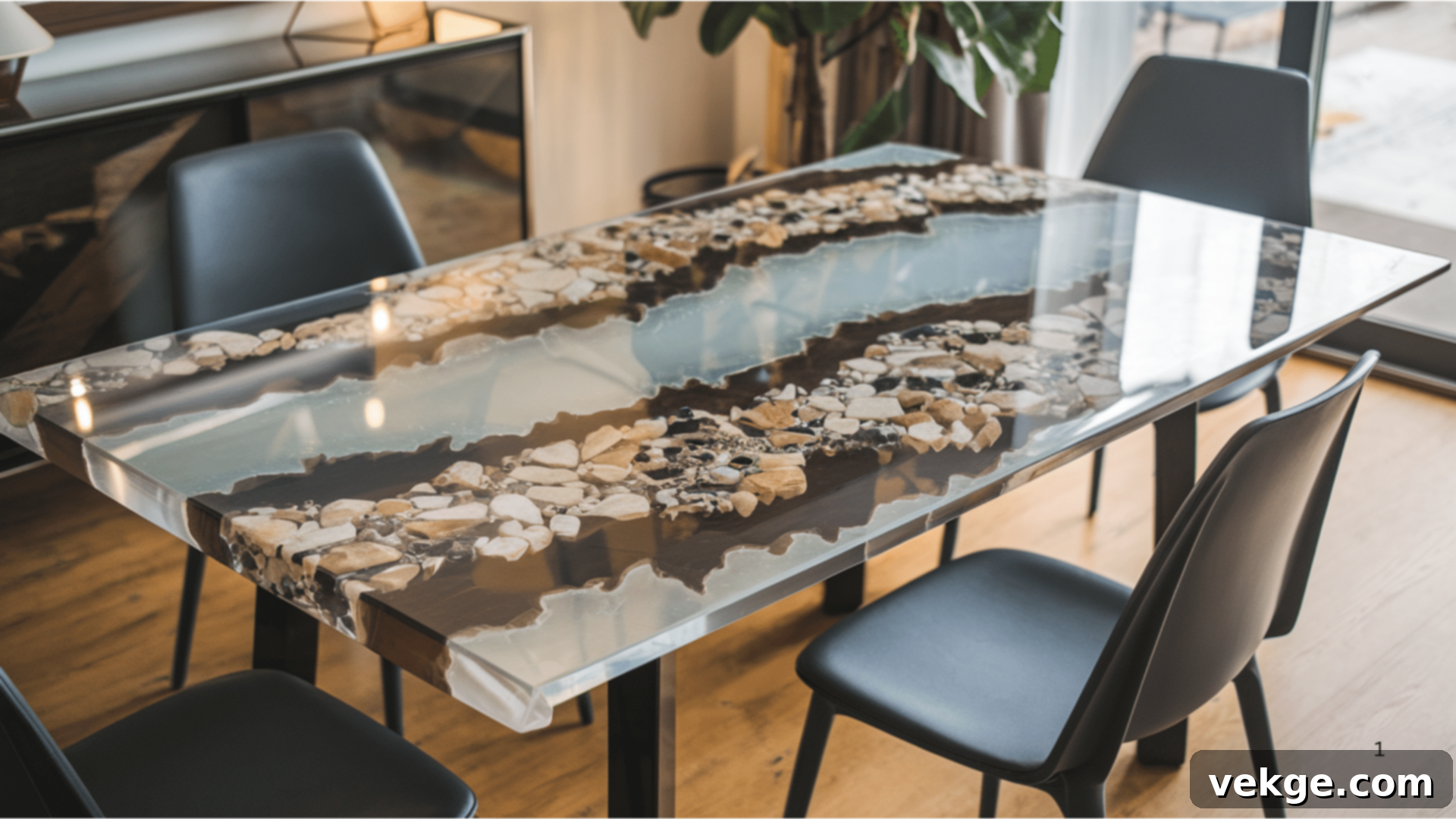
Resin is a highly versatile synthetic material, often used for outdoor tables due to its excellent resistance to weather, UV rays, and moisture. It’s lightweight, easy to clean, and can mimic the appearance of other materials like wood or wicker, making it a flexible choice for casual dining settings or even indoor spaces where durability and easy maintenance are paramount.
- Pros: Water-resistant, UV-resistant, lightweight, very easy to clean and maintain, excellent for outdoor use but also suitable indoors for a casual vibe.
- Cons: May not offer the same luxurious or sophisticated aesthetic as natural wood or stone. Quality can vary, and cheaper resins might not be as durable over time.
Each dining table material brings its own unique character and practical considerations. When making your selection, carefully weigh your room’s style, your budget, the level of maintenance you’re willing to undertake, and how frequently and intensely your table will be used. The perfect material will be one that seamlessly integrates into your home and perfectly meets your lifestyle needs.
Styles of Dining Tables
The style of your dining table sets the tone for your entire dining area, profoundly influencing its aesthetic and atmosphere. From grand and ornate to sleek and minimalist, there’s a style to suit every taste and interior design scheme. Let’s explore some of the most popular dining table styles and their defining characteristics.
Traditional Dining Tables
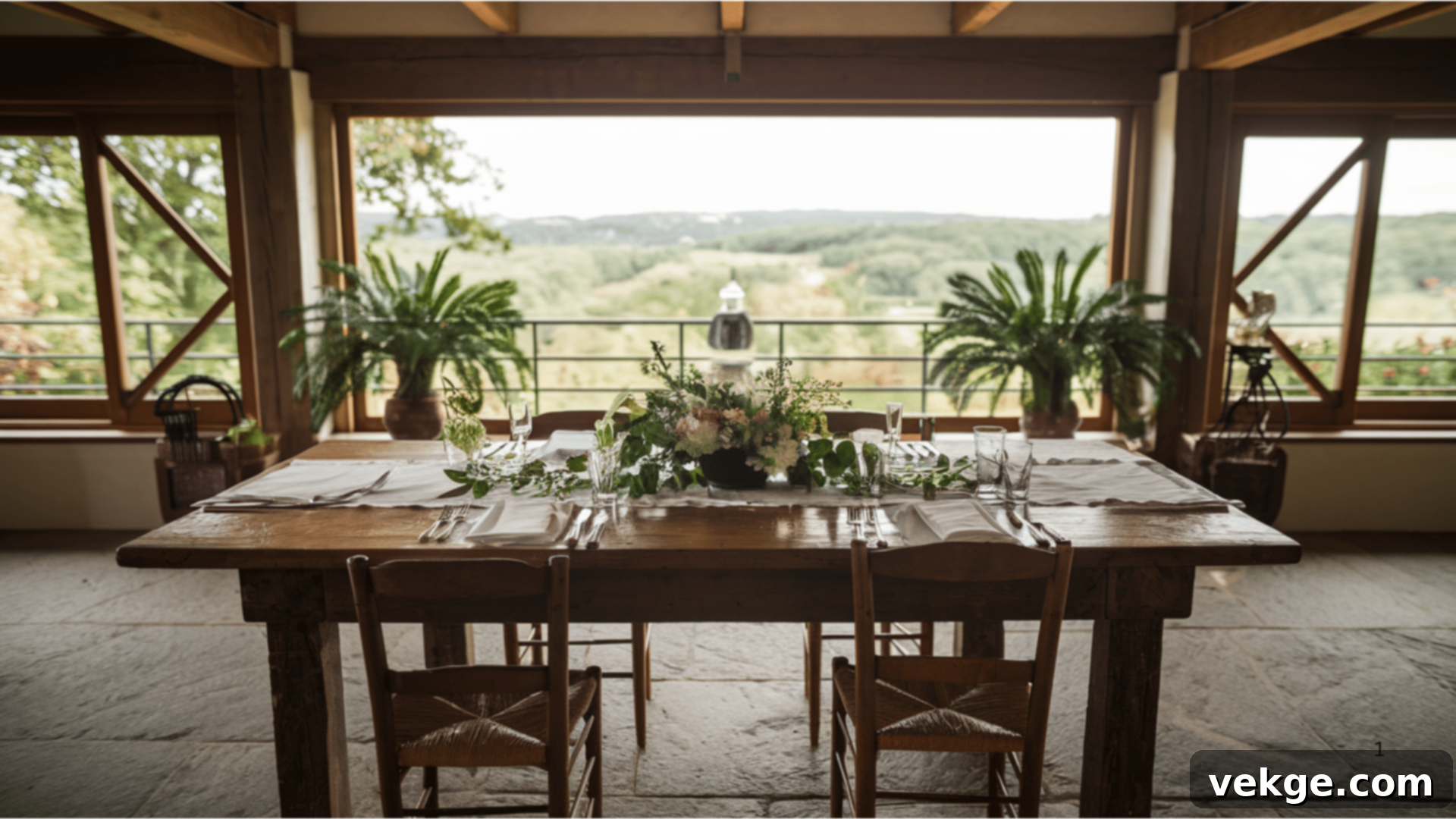
Traditional dining tables evoke a sense of classic elegance and enduring charm. They are often crafted from rich, solid woods like mahogany, cherry, or oak, featuring intricate details such as carved legs, ornate edges, and sometimes a glossy, polished finish. This style is characterized by its formality and often substantial presence, making it ideal for more formal dining rooms or homes with a classic, stately décor that values heritage and craftsmanship.
- Materials: High-quality hardwoods such as oak, cherry, walnut, or mahogany.
- Features: Detailed turnings, carved legs (e.g., cabriole, Queen Anne), ornate apron, rich wood finishes, often grand in scale.
- Best for: Formal dining rooms, classic homes, or spaces designed with a sense of grandeur and history.
Modern Dining Tables
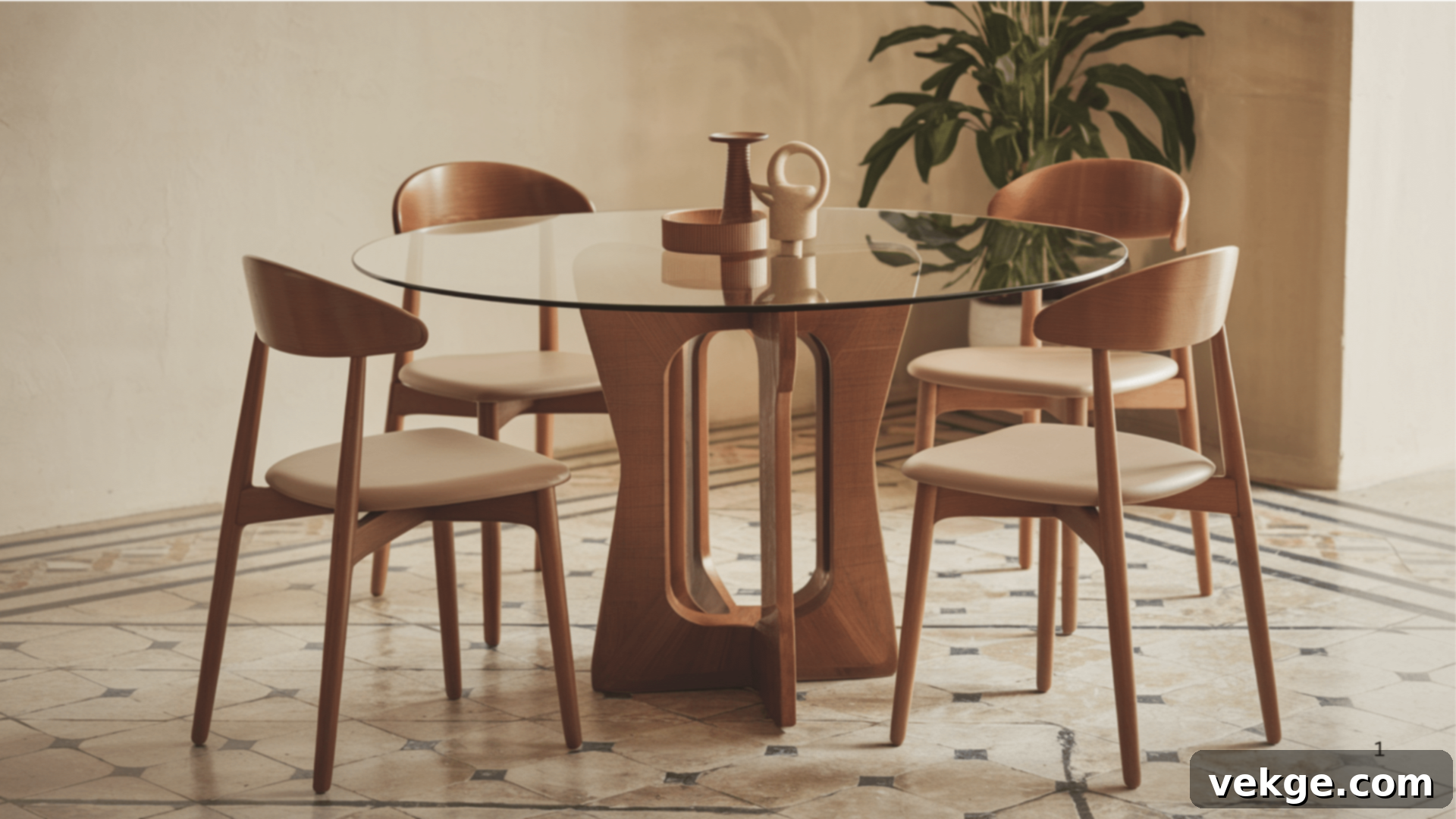
Modern dining tables prioritize simplicity, clean lines, and functionality over ornamentation. They often feature sleek surfaces, geometric shapes, and a minimalist design philosophy. Materials like glass, metal, and polished wood are common, contributing to their contemporary look. These tables are perfect for urban apartments, open-plan spaces, or any home aiming for a clean, uncluttered, and sophisticated aesthetic. Their often lighter visual footprint can also make a smaller space feel more open.
- Materials: Glass, metal (chrome, stainless steel), polished wood, lacquered finishes.
- Features: Minimalist design, clean lines, geometric forms, smooth surfaces, often with striking bases.
- Best for: Modern homes, open-plan living areas, minimalist decor, or spaces where a contemporary, sophisticated look is desired.
Farmhouse Dining Tables

Farmhouse tables are beloved for their warm, inviting, and rustic charm. They typically boast a sturdy, often substantial structure crafted from reclaimed or distressed wood, giving them a lived-in, authentic feel. Characterized by simple, robust designs, sometimes with trestle bases, they create a laid-back, welcoming atmosphere that encourages communal dining and relaxed gatherings. This style pairs wonderfully with a cozy, comfortable interior.
- Materials: Reclaimed wood, distressed wood, pine, oak, often with matte or whitewashed finishes.
- Features: Simple, robust construction, often with a trestle or thick four-legged base, visible wood grain, and a slightly imperfect, rustic feel.
- Best for: Casual dining rooms, country homes, kitchens, or any space aiming for a relaxed, homey, and welcoming vibe.
Industrial Dining Tables
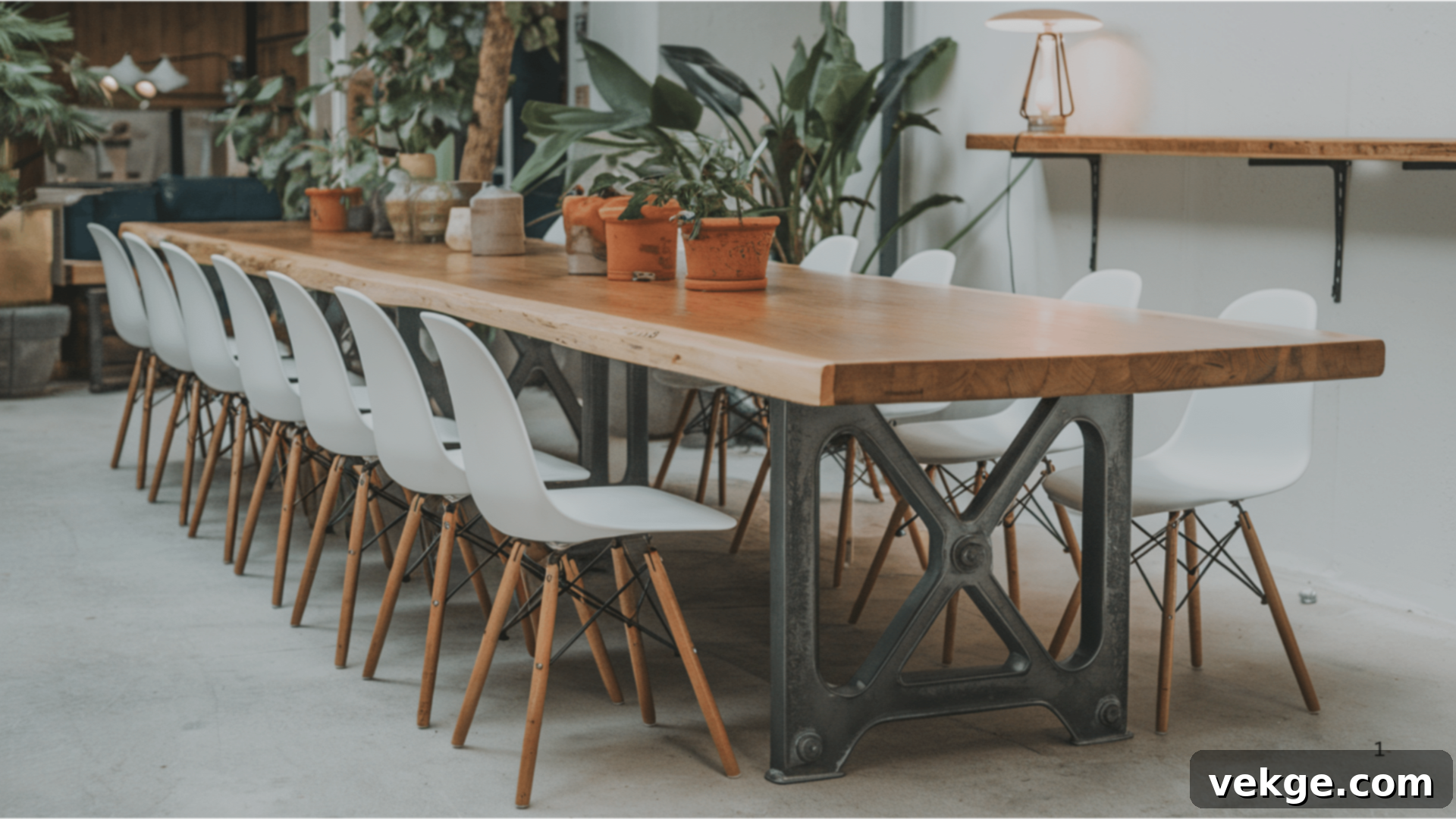
Industrial dining tables embody a raw, urban aesthetic, typically combining robust metal elements with solid wood or concrete tops. They often feature exposed hardware, visible welds, and a weathered or unfinished look, drawing inspiration from old factories and workshops. This style is perfect for those who appreciate an edgy, masculine, and unpretentious vibe, adding character and a sense of history to a space.
- Materials: Metal (steel, iron), reclaimed wood, concrete, often with a distressed or matte finish.
- Features: Raw, unfinished appearance, bold metal details (rivets, exposed bolts), heavy-duty construction, strong lines.
- Best for: Loft-style apartments, urban spaces, industrial-chic interiors, or rooms seeking a raw and edgy modern feel.
Mid-Century Modern Dining Tables
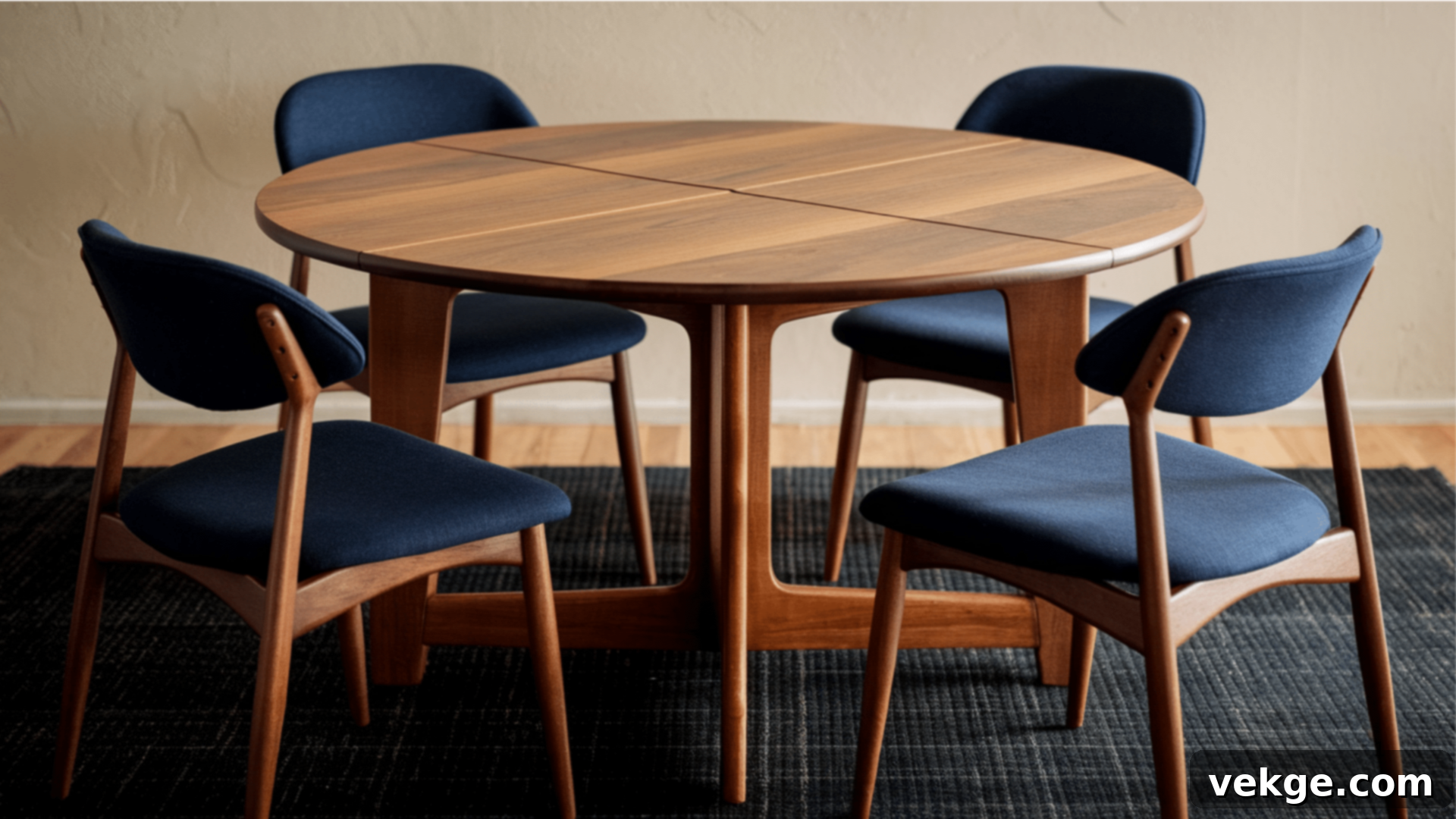
Mid-century modern tables are iconic for their blend of classic elegance and contemporary functionality, stemming from designs popular in the mid-20th century. They feature clean lines, organic shapes, and often distinctive tapered or splayed wooden legs. This style emphasizes craftsmanship and thoughtful design, making it versatile enough to blend with both modern and traditional elements, and it remains highly sought after for its timeless appeal and comfortable sophistication.
- Materials: Teak, walnut, oak, often combined with metal or glass accents.
- Features: Iconic tapered or splayed legs, simple yet elegant design, often with a slightly rounded or organic tabletop.
- Best for: Versatile spaces, retro-inspired décor, or homes looking for sophisticated, functional pieces with a nod to design history.
Rustic Dining Tables
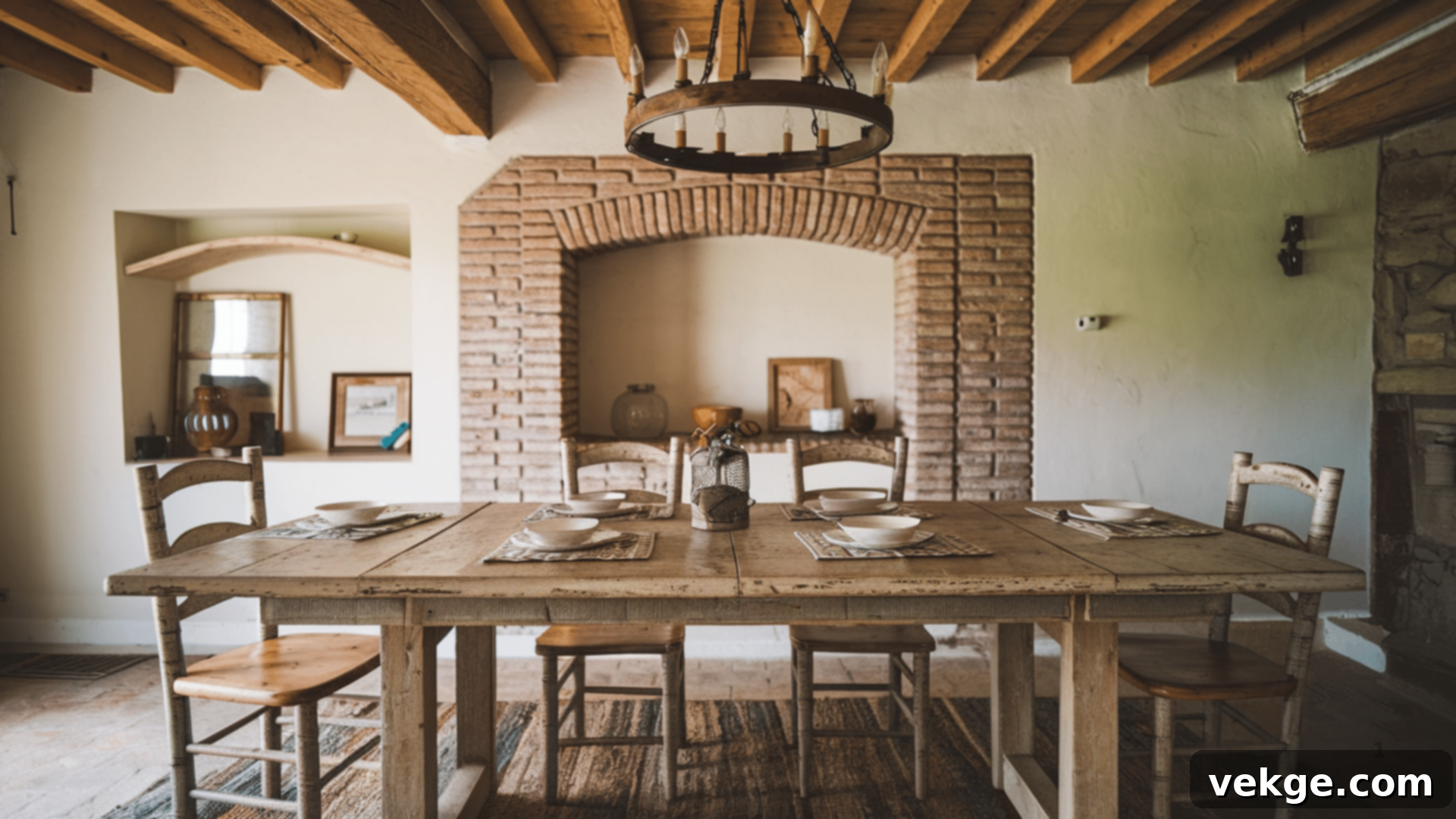
Rustic dining tables celebrate the beauty of natural materials and craftsmanship. These tables typically feature a weathered, unfinished, or rough-hewn look, emphasizing the natural grains, knots, and imperfections of the wood. Often crafted from reclaimed timber or solid wood with minimal processing, they bring an earthy, outdoorsy, and wonderfully authentic feel to your dining area. They are perfect for creating a warm, grounded, and unpretentious atmosphere.
- Materials: Reclaimed wood, rough-hewn timber, solid wood with natural finishes (e.g., cedar, pine).
- Features: Visible wood grains and knots, rough textures, sturdy construction, natural and unpolished appearance.
- Best for: Country homes, cabins, mountain retreats, or any nature-inspired space seeking a cozy, earthy, and genuine feel.
Contemporary Dining Tables
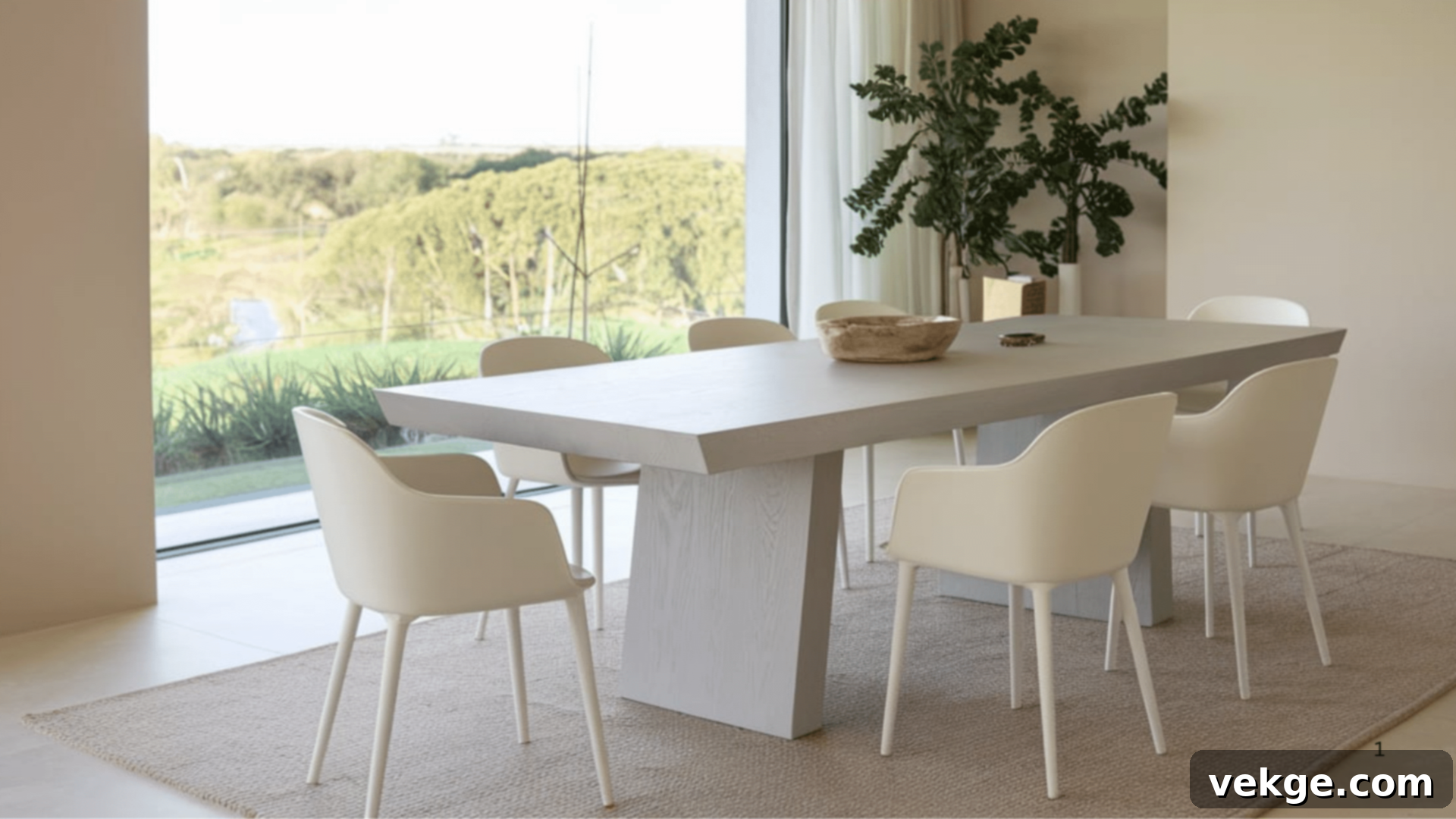
Contemporary dining tables encompass current design trends, often blending elements from modern, minimalist, and even traditional styles to create something fresh and relevant. They focus on bold shapes, innovative materials, and a sense of understated sophistication. Contemporary tables are sleek yet often approachable, perfect for those who desire a cutting-edge look that still feels inviting and relevant to today’s living spaces.
- Materials: A mix of glass, wood, metal, acrylic, or even stone.
- Features: Bold geometric shapes, sculptural bases, clean lines, sometimes with unexpected material combinations.
- Best for: Modern or eclectic homes, urban lofts, or anyone looking for a stylish and current design statement.
Scandinavian Dining Tables
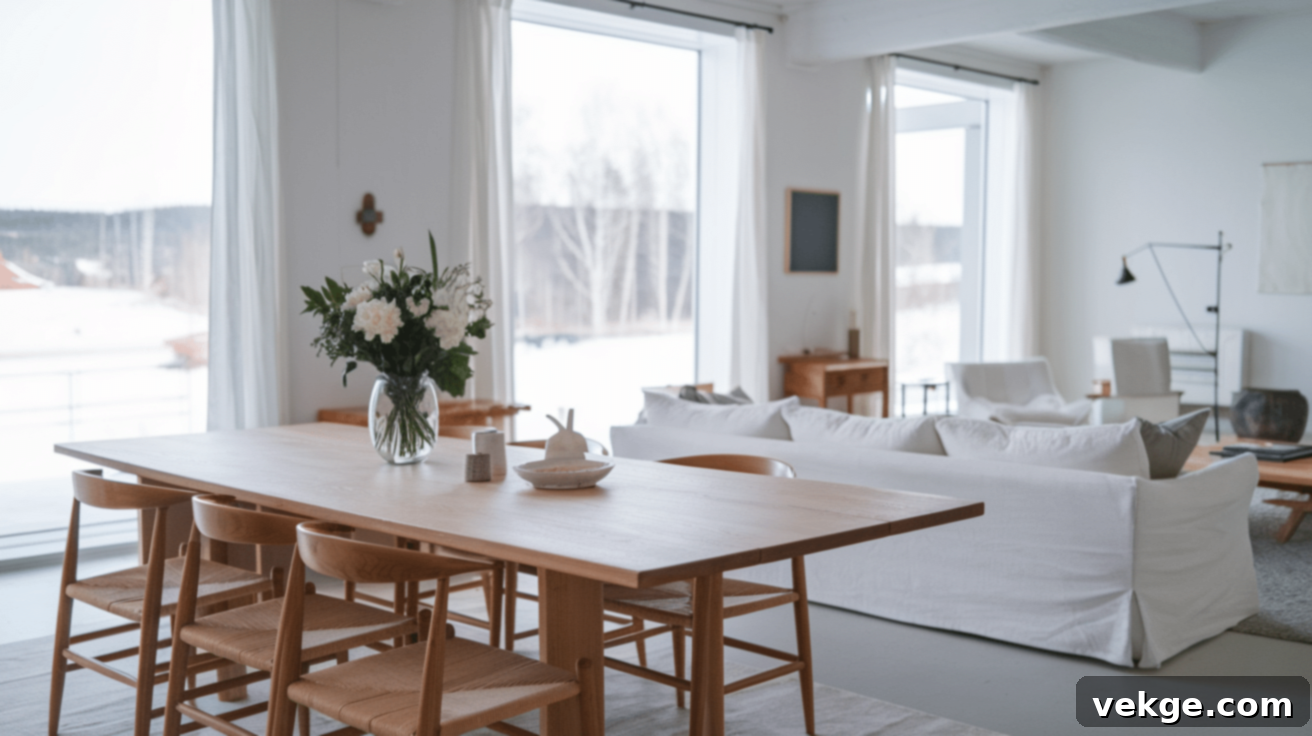
Scandinavian dining tables are synonymous with simplicity, functionality, and a light, airy aesthetic. They emphasize natural materials, particularly light-toned woods like birch, pine, or light oak, combined with clean lines and minimal ornamentation. The focus is on creating a bright, uncluttered, and serene environment, promoting a sense of calm and hygge. These tables are perfect for achieving a fresh, minimalist look that is both practical and beautiful.
- Materials: Light wood (birch, pine, light oak, ash), often with matte or natural finishes.
- Features: Simple, functional design, tapered legs, often rounded edges, a focus on natural light and warmth.
- Best for: Modern homes, minimalist spaces, bright interiors, or anyone seeking a clean, fresh, and functional design.
Pedestal Dining Tables
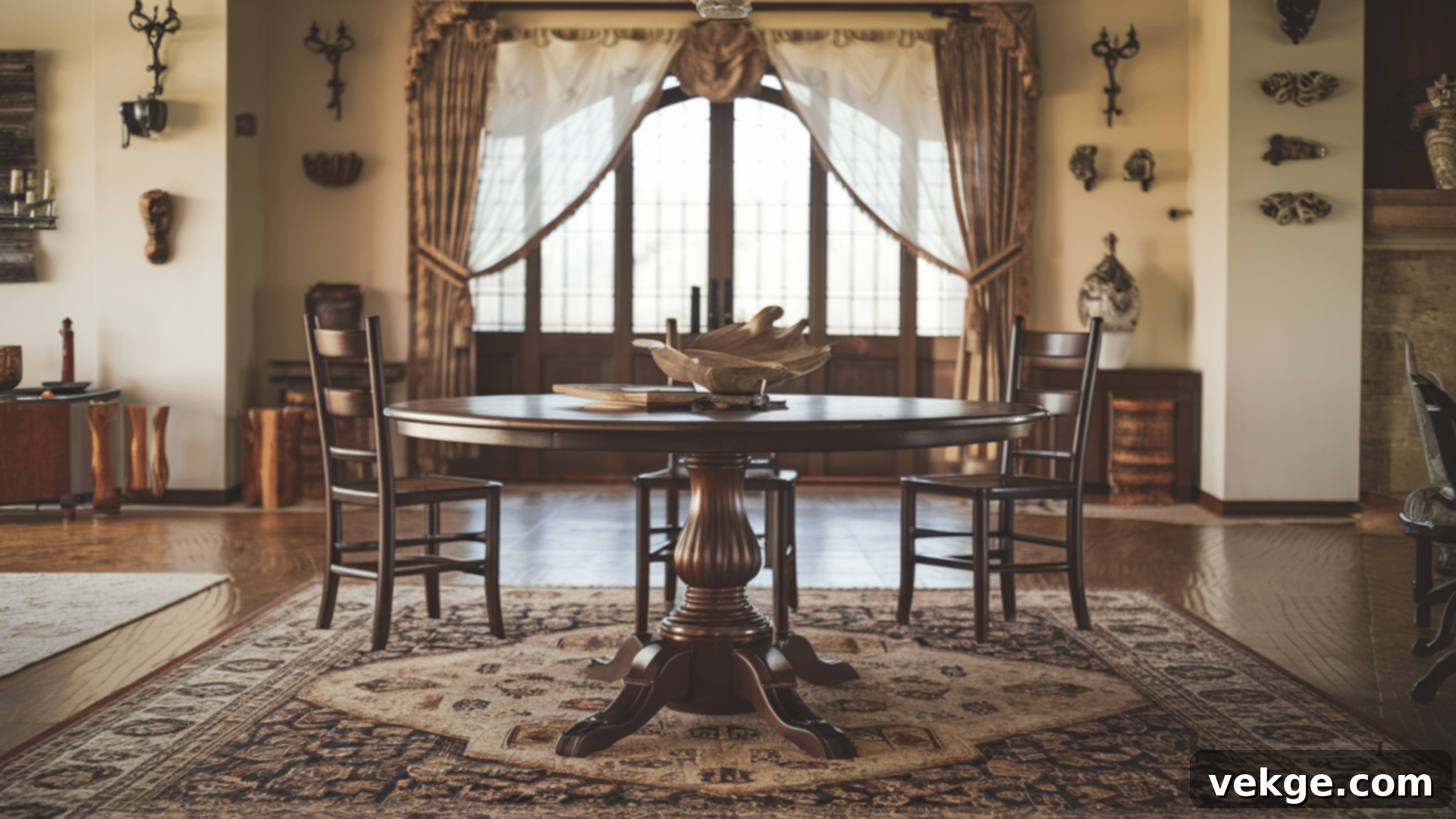
As previously discussed in the base section, pedestal tables feature a single central support column or a cluster of supports, rather than individual legs at each corner. This design offers a significant advantage in terms of legroom and seating flexibility, as there are no obstructions. Pedestal tables are available across a vast range of styles, from traditional carved wood pedestals to sleek, modern metal or glass designs, making them highly adaptable to various decor schemes.
- Materials: Wood, metal, marble, glass (for the top).
- Features: Single central base, absence of corner legs, can be round, square, or oval.
- Best for: Smaller spaces where maximizing legroom is crucial, modern or traditional settings seeking an uncluttered look, and enhancing intimate conversation.
Folding Dining Tables
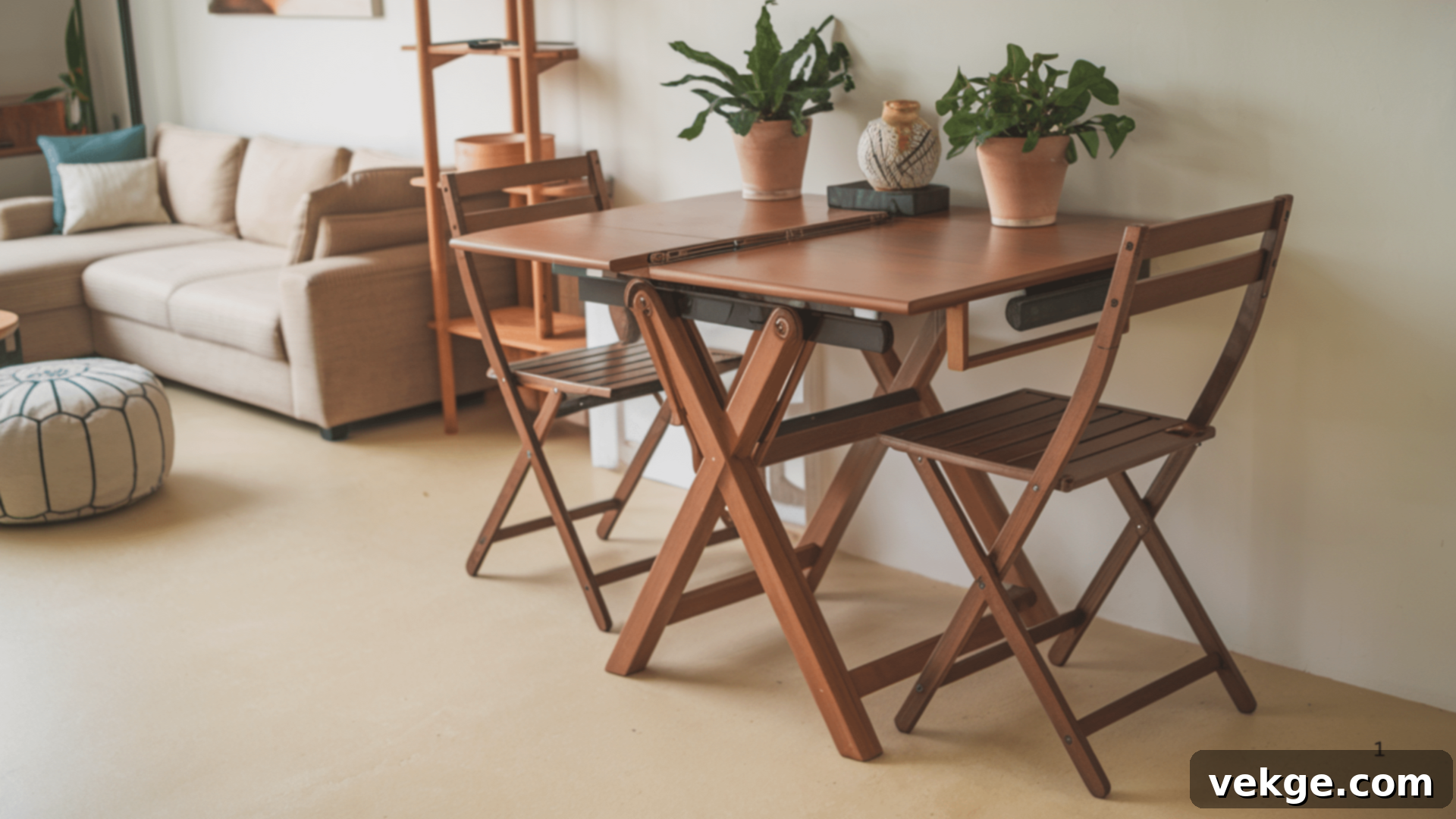
Folding dining tables are the ultimate solution for spaces where flexibility and compactness are paramount. These tables can be completely folded down and stored away when not in use, making them incredibly valuable for small apartments, studio living, or as auxiliary tables for larger gatherings. They are designed for quick setup and takedown, offering versatility without permanent commitment to floor space.
- Materials: Often lightweight wood, metal, or plastic for ease of movement.
- Features: Expandable, compact design, often with drop-leaf sides or full folding capabilities.
- Best for: Small apartments, multifunctional rooms, guest rooms, or as an occasional dining solution.
Extension Dining Tables
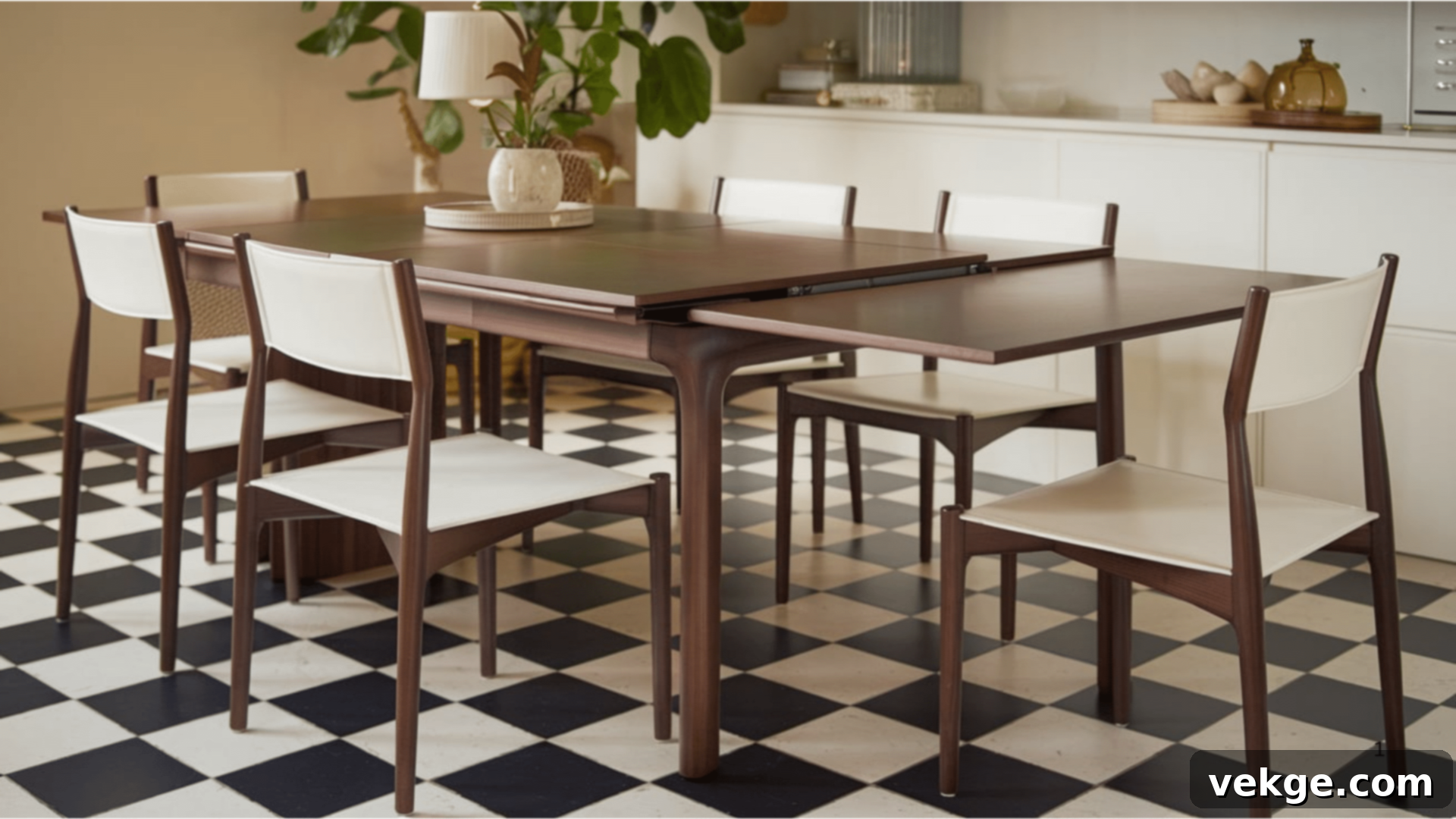
Extension dining tables, like butterfly tables, are designed to adapt to your needs, making them perfect for growing families or frequent entertainers. They feature removable or fold-out sections (leaves) that can be inserted to extend the table’s length, providing additional seating capacity when required. This allows for the convenience of a smaller table for daily use and the functionality of a larger table for special occasions, offering excellent value and versatility without requiring a large permanent footprint.
- Materials: Wood, metal, glass, or a combination.
- Features: Adjustable length, often with one or more additional leaves or internal extension mechanisms.
- Best for: Large families, frequent entertainers, or homes where space needs to be adaptable.
Each of these dining table styles offers a unique set of characteristics that can greatly enhance your home’s aesthetic and functionality. The ideal choice for you will ultimately depend on your personal taste, the dimensions and existing decor of your space, and the specific atmosphere you wish to cultivate within your dining area.
Choosing the Best Dining Table for Family vs. Entertaining
When you embark on the journey of selecting a new dining table, it’s crucial to first consider its primary purpose. A table designed for daily family meals will likely have different requirements than one intended mainly for formal entertaining. Let’s explore the distinct needs of each scenario to help you make the most informed decision.
For a table dedicated to everyday family dinners, comfort, practicality, and durability should be your top priorities. This table will endure daily use, spills, homework sessions, and potentially creative projects. It needs to be resilient and forgiving.
- Size and Shape: Choose a table that’s generously sized for everyone to sit comfortably, allowing for elbow room and space for serving dishes. Round or oval tables are often excellent for families as they foster easier conversation among all members and have no sharp corners, which is a bonus for homes with young children.
- Material: Opt for highly durable and easy-to-clean materials. Solid wood with a protective finish, laminate, or even certain types of engineered stone can withstand daily wear and tear. Glass might require more frequent wiping, and unsealed marble could stain easily.
- Maintenance: Look for a table that requires minimal fuss. Easy cleaning and resistance to scratches and spills will save you time and stress in the long run.
- Comfort: Pair the table with comfortable, sturdy chairs that can withstand daily use and provide good back support for extended family time.
When the focus shifts to a table for entertaining guests, style, flexibility, and a touch of elegance often come to the forefront. This table is about making a statement and creating a memorable experience for your guests.
- Size and Flexibility: Consider a larger table or, even better, an extendable dining table. This allows you to accommodate varying numbers of guests, from intimate dinner parties to larger holiday gatherings, without committing to a permanently oversized table.
- Design and Statement: Look for a table that makes a visual statement—something elegant, unique, or luxurious that complements your entertaining style. A stunning marble top, a table with an artistic base, or a beautifully crafted solid wood piece can be a conversation starter.
- Materials: Materials like polished wood, marble, or even a glass top with a sophisticated base can add a touch of sophistication and grandeur. While durability is still important, the emphasis might lean more towards aesthetics and visual impact for occasional use.
- Ambiance: The table should provide a beautiful canvas for your table settings, centerpieces, and overall decor, enhancing the celebratory atmosphere.
By carefully considering how your dining table will be used most frequently – whether as a workhorse for family life or a showpiece for special occasions – you can narrow down your options and find the perfect table that not only fits your space but also perfectly suits your unique lifestyle and entertaining needs.
Budget-Friendly Dining Table Options
Creating a beautiful and inviting dining space doesn’t necessarily require a significant financial investment. We understand that finding a stylish, functional dining table on a budget can be a challenging task. However, with a bit of savvy shopping and creativity, there are plenty of affordable options that will look fantastic in your home without breaking the bank.
- Explore Secondhand and Vintage Finds: Thrift stores, antique shops, consignment stores, flea markets, and online marketplaces (like Facebook Marketplace, Craigslist, or eBay) are treasure troves for solid, well-built tables at significantly lower prices. You can often find pieces with “good bones” – sturdy construction and classic designs – that can be easily updated with a fresh coat of paint, a new stain, or updated hardware to give them a modern, custom look. This approach also promotes sustainability!
- Opt for Simple, Clean Designs: Tables with basic, straightforward designs often cost less to manufacture and, consequently, to purchase. Choosing something clean and simple, like a classic rectangular or round table with a minimalist base, allows you to save money without sacrificing style. These simple designs are also incredibly versatile and can adapt to various decor changes over time.
- Consider Materials Like MDF, Particleboard, or Veneer: While solid wood tables are beautiful, they come with a higher price tag. More affordable alternatives include tables made from MDF (medium-density fiberboard), particleboard, or veneer (a thin layer of real wood over a composite core). These materials can still provide a polished, attractive look and good durability for everyday use at a fraction of the cost of solid timber. Modern manufacturing techniques mean these options are often quite sturdy and aesthetically pleasing.
- Embrace DIY Projects: If you’re handy and enjoy a creative challenge, building your dining table can result in substantial savings. There are numerous easy-to-follow tutorials available online (on platforms like YouTube, Pinterest, or design blogs) that guide you through constructing a stylish dining table using basic tools and readily available materials like plywood, reclaimed wood, or even standard lumber from a hardware store. This also allows for complete customization to your exact specifications.
- Check Out Big-Box Retailers, Online Discounters, or Outlet Shops: Large retailers like IKEA, Target, Walmart, and online furniture discounters (Wayfair, Amazon, etc.) or local furniture outlet stores frequently carry a wide selection of stylish and affordable dining tables. These stores excel at offering mass-produced designs that are both functional and aesthetically pleasing at competitive price points. While they may not be heirloom quality, they offer excellent value for money and look great in most contemporary homes.
- Look for Sales and Clearance Events: Keep an eye out for seasonal sales events (like Black Friday, end-of-season clearances, or holiday promotions) at furniture stores. You can often find significant discounts on floor models or discontinued lines, allowing you to snag a higher-quality table at a budget-friendly price.
With a little bit of research, creativity, and patience, you can absolutely find the perfect dining table for your space without overspending. It’s all about knowing where to shop, what materials to consider, and being open to refreshing a pre-loved piece!
Mixing and Matching Chairs
Mixing and matching dining chairs is a fantastic way to infuse personality, eclectic charm, and unique style into your dining area. Far from being a random assortment, successful chair mixing is an art form that requires balance, thoughtful consideration, and a dash of creativity. It allows you to break away from traditional uniformity and create a truly bespoke look.
Before you begin, consider the overall aesthetic or mood you wish to achieve. Do you envision a bohemian eclectic vibe, a refined blend of modern and vintage, or a more subtle, harmonized variation? Both a bold, striking mix and a subtly cohesive blend can work beautifully, depending on your personal taste and existing decor.
Here are some expert tips for successfully mixing and matching dining chairs:
- Establish a Unifying Theme: This is perhaps the most crucial rule. While the chairs themselves are diverse, they should share a common element to prevent a chaotic look. This unifying theme could be:
- Material: Stick to all wooden chairs, but vary their styles (e.g., a Windsor chair, a modern slat-back, a rustic bench).
- Color: Use chairs of different designs but paint them all the same color (e.g., all white, all black, or a specific accent color).
- Era/Style: Mix different chairs from the same design era (e.g., all mid-century modern designs, even if they have different legs or backs).
- Height: Ensure all chair backs are roughly the same height, or use a few taller chairs at the ends and shorter ones along the sides.
- Vary Textures for Depth: Introduce visual interest by pairing different textures. For example, combine sleek metal chairs with warm wooden ones, or upholstered chairs with rattan or woven seats. This contrast adds richness and dimension to your dining space.
- Play with Sizes and Shapes Thoughtfully: While you can vary sizes, aim for a balanced composition. A common technique is to use two larger, more prominent chairs (often armchairs) at the head and foot of a rectangular table, and then smaller, armless chairs along the sides. Alternatively, mix a dining bench on one side with individual chairs on the others.
- Use Color Strategically: If you’re incorporating different colors, ensure they either belong to the same color family (various shades of blue, for instance), are complementary colors (e.g., blues and oranges in muted tones), or follow a consistent palette (e.g., pastels, earth tones). Avoid too many clashing, vibrant colors unless that’s your specific, intentional aesthetic. Neutral chairs mixed with one or two accent colors can be a safe and stylish approach.
- Maintain Consistent Seat Height: Regardless of their style, ensure all chairs have a similar seat height. This is essential for practical comfort, allowing everyone to sit comfortably at the table without awkward height differences.
- Start with a Core Set: If you’re new to mixing and matching, start with a consistent set of 2-4 chairs, and then introduce 1-2 different chairs to the ends or opposing sides. This provides a baseline of cohesion.
- Consider Your Table: Let your dining table be the anchor. If your table is simple and modern, you can go bolder with your chair choices. If your table has a lot of character or detail, simpler mixed chairs might be more appropriate.
Mixing and matching dining chairs is a fantastic opportunity to express your personal style and create a dynamic, interesting, and comfortable dining space. By applying these strategic tips, you’ll ensure that your diverse chairs work together harmoniously, resulting in a cohesive and visually appealing dining area that you and your guests will love.
Care and Maintenance of Dining Tables
Your dining table is a significant investment and a central piece of furniture in your home. Proper care and regular maintenance are essential not only to preserve its beauty and functionality but also to extend its lifespan for many years to come. Here are some easy-to-follow steps and practical tips to keep your dining table looking its best, regardless of its material.
- Regular Cleaning is Key: Make a habit of wiping down your table after every meal or use. For most surfaces, a soft, damp cloth is sufficient to remove dust, crumbs, and fresh spills. For deeper cleaning, use a cleaner specifically formulated for your table’s material. For wood, use a wood cleaner; for glass, a glass cleaner; for stone, a pH-neutral cleaner. Always follow the manufacturer’s instructions.
- Avoid Harsh Chemicals and Abrasives: Steer clear of all-purpose cleaners, ammonia-based products, or abrasive sponges unless explicitly recommended for your table’s material. These can strip finishes, etch surfaces, or leave permanent scratches. When in doubt, a mild soap and water solution is usually safe for most sealed surfaces, followed by a thorough drying.
- Protect from Heat, Moisture, and Scratches: This is paramount for preventing damage.
- Use Coasters: Always place coasters under glasses, cups, and bottles to prevent unsightly water rings and condensation marks.
- Use Placemats: Placemats act as a barrier against spills, food stains, and heat from plates. They also help to reduce scratches from cutlery.
- Use Trivets or Hot Pads: Never place hot dishes directly onto the table surface. Always use trivets or hot pads to protect against heat damage, which can cause warping, discoloration, or bubbling of finishes.
- Avoid Dragging Objects: Lift items rather than dragging them across the table to prevent scratches.
- Polish and Condition Wooden Tables: If you have a wooden table, periodic polishing or conditioning is crucial to maintain its natural luster and prevent the wood from drying out and cracking. Use a high-quality wood polish or furniture oil designed for your specific wood type and finish. Apply sparingly with a soft cloth and buff gently according to product instructions, typically every few months or as needed.
- Protect from Direct Sunlight and Extreme Temperatures: Prolonged exposure to direct sunlight can cause wood to fade, crack, or warp, and can also affect the color of other materials. Position your table away from direct sunlight or use blinds/curtains during peak sun hours. Avoid placing tables near radiators, heating vents, or air conditioning units, as extreme temperature fluctuations can also cause material stress and damage.
- Address Spills Immediately: No matter the material, spills should be cleaned up as quickly as possible. Liquids, especially acidic ones like wine or citrus juice, can etch or stain surfaces, particularly porous materials like unsealed marble or unsealed wood, if left for too long.
- Check and Tighten Hardware: For tables with bolts or screws, especially extendable or modular designs, periodically check and tighten any hardware. This helps maintain the table’s stability and prevents wobbling over time.
A small amount of proactive care goes a long way in preserving the beauty and integrity of your dining table. By consistently following these simple maintenance tips, you’ll ensure your dining table remains a stunning and functional centerpiece in your home for many enjoyable years.
Conclusion
Transforming your dining table into a stylish and inviting focal point is one of the most rewarding ways to enhance your home’s atmosphere. Throughout this guide, we’ve explored the essential elements that contribute to a perfectly curated dining space – from the foundational choices of size, shape, base, and material to the nuanced decisions of style and decor.
Remember, the key to creating a beautiful and functional space lies in a thoughtful approach. By carefully considering your room’s dimensions, your lifestyle needs (whether for family or entertaining), and your personal aesthetic preferences, you can select a dining table that truly complements your home. Then, with the right décor, considerate place settings, and a harmonious match to your room’s overall style, your dining area will come alive.
Always aim for balance and functionality. Don’t overcrowd your table with excessive decor; instead, allow each chosen piece to shine and contribute to the overall aesthetic. The goal is to create an inviting environment that feels both sophisticated and comfortable.
With these practical and easy-to-implement tips, you are now equipped to breathe new life into your dining table, making it a source of joy and beauty for both everyday meals and your most cherished special occasions. The most important ingredient in this process is to have fun with it and imbue the space with your unique personality. Trust us, with just a few thoughtful touches, your dining table will undoubtedly become a beloved heart of your home, drawing people together and creating lasting memories.
So, go ahead – start styling, embrace the process, and enjoy your beautifully transformed dining space!
Frequently Asked Questions
How Do I Choose the Right Centerpiece for My Dining Table?
Choosing the right centerpiece involves considering both scale and style. Select a centerpiece that is proportionate to your table’s size – not too large to obstruct views or too small to get lost. It should also align with your room’s overall decor and the occasion. For daily use, opt for something simple yet elegant like a low floral arrangement, a decorative bowl with natural elements (e.g., fruit or stones), or a cluster of candles. For special occasions, you can be more elaborate, but always ensure guests can still converse easily across the table. Natural elements, fresh flowers, or seasonal decor are always excellent choices.
How Can I Style a Dining Table for Everyday Use?
Styling for everyday use should prioritize simplicity, functionality, and ease of maintenance. The goal is to make the table appealing without being cumbersome. Start with a simple, easy-to-clean base layer like placemats (which also protect your table). A small, unobtrusive vase with fresh flowers or greenery, or a stylish fruit bowl, can add life without taking up too much space. Ensure there’s always ample room for plates, glasses, and serving dishes. The beauty of everyday styling lies in its understated elegance and practicality.
What’s the Best Way to Arrange Table Settings?
A classic table setting provides a neat and organized foundation. Place the dinner plate in the center of each place setting. The fork goes to the left of the plate. To the right of the plate, place the knife (with the blade facing the plate), and then the spoon next to the knife. Napkins can be placed on the plate or to the left of the forks. Glasses go above the knife, typically starting with the water glass. Keep it uncluttered and functional, ensuring each guest has everything they need within easy reach.
How Often Should I Change the Décor on My Dining Table?
The frequency of changing your dining table décor is entirely up to your preference and lifestyle! Many people enjoy refreshing their decor seasonally (e.g., spring florals, autumnal gourds, winter evergreens) to reflect the time of year or upcoming holidays. Others might change it monthly for a fresh look, or simply whenever they feel inspired to try something new. The beauty of decor is its flexibility, allowing you to easily update the mood and style of your dining space without major investment.
Can I Mix Different Styles of Tableware?
Absolutely, mixing different styles of tableware is a popular and sophisticated way to create a personalized and visually interesting table! The key is to ensure there’s a cohesive element that ties everything together, preventing a chaotic appearance. This could be a consistent color palette (e.g., mixing different patterns of blue and white plates), a shared material (e.g., combining various ceramic patterns), or a common theme (e.g., all vintage pieces). Pairing rustic chargers with delicate modern plates, or traditional cutlery with minimalist serving dishes, can create a rich, layered look that tells a story and feels uniquely yours. Experiment and trust your eye for balance!
